Microcosmographia
Plebe #11
William Van Hecke is a dear friend who has been writing an email newsletter called Microcosmographia. Over seven years, William has published 29 wonderful issues that I'm combining into Plebe #11 with their permission.
Reading it all from from start to end is a thrill because it doesn't follow a tidy story arc. There's no hero assigned to defeat a series of challenges and a big dragon at the end. It's more messy and exploratory, like real life.
William started with tangible insight – "I think social media is a bad arena for thinking big, nuanced thoughts" – then set off on a grand adventure to get some real thinking and reflection done. (A bit like Zen & the Art of Motorcycle Maintenence, come to think of it.)
I love every word, and I'm excited to share it with you as Plebe #11. Happy exploring!
Exile in Hashtagtinople
January 28, 2015
Nickd’s recent letter Escape from Hashtagistan, and the links therein, are probably what finally convinced me, but there have been several other nudges. I spent half of last year developing a talk about how creative people interact with the wider world, called Your App Is Good And You Should Feel Good; all the research and thinking that went into it left me with a much-diminished view of the healthiness of social network sites as one’s primary way of connecting to people. And CGP Grey’s The Professional Sharer reminded me that there is actually a pretttty good technology out there for putting strings of text in front of people who want them, and isn’t bound to mutate over time in pursuit of some company’s business interests and at the expense of its users — email!
Essentially, I’d like a way to say things out loud that encourages thoughtful, joyful conversations, and it is starting to look like email is a better way to do that. I’d like a better way to start a few deep conversations in private, not just lots of frustratingly superficial ones in public. So maybe sending out a letter once in a while will fill a need that was too often served by cramming my thoughts and conversation prompts into tweets.
A Music Album For Your Consideration
My brain likes obsessive phases, and right now my musical obsession is Different Every Time by Robert Wyatt. This is a 146-minute tour through Wyatt’s wild, weird, five-decade career. Somehow, the huge range of idioms, genres, and eras flows together as if the ultimate goal of all the prog and jazz bands, avant-garde solo projects, and hip guest appearances was to craft this compilation album. It’s a journey of an album — dreamlike, charming, unassailably cool, and consistently sincere.
Zoom Out
February 4, 2015
Do you know Bret Victor? He’s a universally well-regarded thinker on the topic of how humans work and learn with technology. A lot of smart people consider his Inventing on Principle to be one of the best talks of all time for people who, like, make things, or… do things. I got to see him speak about Up and Down the Ladder of Abstraction at Edward Tufte’s See Think Design Produce seminar. His newest talk is called The Humane Representation of Thought, and it is also very good. The subtitle of that talk is “A trail map for the 21st century”. There is a thread through most of Victor’s work, and the way he talks about it, that makes it pretty clear: his thinking and his work are focused at the century level. He wants to do work that’s important enough to be remembered in holo-textbooks of the 22nd century. Maybe if he does a good job, he could have a multi-century impact.
Andy Matuschak’s blog Square Signals is post after post about this sort of thinking, and the values you end up with if you focus on that scale. (Incidentally, I met Andy at that Tufte/Victor event! He borrowed my notebook.) David Deutsch’s book The Beginning of Infinity argues for a worldview in which humans have started down a path of infinite progress, which you can participate in, probably at century scale.
Sheeeeeesh. Okay, so that is an intimidating boggle. Like, if you aren’t making a dramatic difference to people’s lives four generations out, jeez, what are you even doing on this planet, right? But while I was dwelling on all that, I also happened to be absorbing some stuff on vastly larger scales. Numenera, a tabletop RPG set a billion years in the future, when Earth is utterly unrecognizable. Iain Banks’ Culture series of novels, which take place in a galactic civilization so advanced that the only real threat is boredom. And the excellent Wait But Why post about the Fermi Paradox, which takes very seriously the possibility of hyper-advanced civilizations in our own galaxy right now. (Group 2 Possibility 3 for life!) At scales like that, century thinking seems… quaint? Self-important? How much of a role can you really believe you are playing in the fate of intelligent consciousness in this universe a dang billion years from now? So I started this exercise of trying to zoom out from where I’m sitting to look at as many time-scales as possible, and to think on what seems important to people at each one. This is superbly calming and meditative.
1 hour: I am gonna eat this junk food and it will totally make me happy
1 day: I am gonna be lazy and look at the internet instead of working on stuff; I probably deserve it?
1 year: I am totally gonna be popular in the scene this year
1 decade: I am gonna work hard at my career and reap the appropriate rewards
1 generation: I am gonna raise a kid to be a good and successful person
1 lifetime: I am gonna do things that I believe in, and sustain them for a long time, to make the world somewhat better while I am here
100 years: I am gonna advance my field with new thinking and be remembered in holo-textbooks
1000 years: I am gonna fundamentally change the way our species inhabits the universe by making some world-changing discovery — can any one person really do this, or is the discoverer just the person who happened to be working on it when a leap happened?
10,000 years: Uh, is anyone gonna care in 10,000 years who did a thing? Does it matter which individual person first discovered how to control fire, grow crops, or write?
100,000 years: Oh, hmm, is anyone even gonna be around? Will civilization as we know it even exist anymore? What can it even mean to think and act on this scale?
1,000,000 years: Forget it, who cares
1,000,000,000 years: YEAH NUMENERA
We disapprove when people only see the narrower views, and don’t plan for their own futures. And we admire people who sacrifice those lower levels to tilt toward the higher levels. After writing it all out, I think the natural center is at 1 lifetime. Which is I guess where I have been focused! I really want to use the understanding we have as a species to make tools for people to do meaningful things. But I am also careful to enjoy my own time here. I’m not so sure I want to sacrifice too much on those more individual-human time scales in order to do the truly profound stuff at the longer-term levels. There’s a balance to be found. Maybe someday I will get a chance to work directly on some century stuff. But I know that things I have helped make, by doing my narrower-scale work, are being used by many people to do century stuff. Which might be even better? Question marks??
A Novel For Your Consideration
I love everything about Ancillary Justice by Ann Leckie, but it’s best if you go onto it now knowing what to expect. I’ll just say it’s science fiction avec feels. But I’ll gladly talk about how it was written. I love that Leckie shipped it, her first novel, at nearly 50, after having several other jobs and being a stay-at-home mom of two. I love that the whole project started as a National Novel Writing Month exercise, and took ten years of on and off tinkering to finish. I love that what had begun as a project for fun went on to win nearly every major science fiction award. Everything about it denies the narrative of the obsessively creative life, the story that says if you didn’t decide at age 10 to be something and then dedicate yourself utterly to it, you’ll never be great. Some of my favorite artists did follow that path, but it is nice to hear that you can also succeed while being healthy and balanced, and you can try different things at different times in your life.
Creativity Hax
February 11, 2015
Pretty tired today! I am trying segmented sleep again, and am not quite used to it yet. But I have an old email here that I sent to my dear friend Jon Bell, and I think some more folks might be interested in it. So the main text today is a lightly edited version of that!
You know I like to make jokes about how I’ve found “the difference between you and me”. You’re a screen-toucher, and I’m not. You’re the one who gets people whiteboarding and drawing on stickies to figure out design directions, and I’m the one who sends them a followup email with lists of detailed suggestions.
So here’s another one: you’re the person who relies on productivity hacks, and I’m the one who relies on creativity hacks. You’re doing purely creative stuff all the time, but I haven’t been able to do that since high school. As much as I like to think of myself as a creative person, and to imagine the completely original art projects I’d love to do (on a platter with glitter and everyone’s clapping), I don’t ship. Sure, I can build websites in service of some purpose I’m interested in, or code useful tools for myself, or oh yeah, write a book about software. But for a really long time I couldn’t bring myself to make art.
Well, right now I have got one of the biggest creative projects of my life in an active and ongoing creation process. It’s a fiction project that can continue indefinitely, based on a premise that quite literally came to me in a dream at 5:37 AM on October 16th, 2012 — one of the first times I took melatonin. And I’m actually shipping it! That is something I haven’t done since… since my webcomic died out in 2003, I guess. The process is working!!
Here’s how I hacked my creativity.
- Be anonymous — I probably got this from you. My project is out there on the web where anyone can read it, but it’s not connected to me in any way. Anxiety about what people will think didn’t help me ship, so I got rid of it.
- Write a paragraph a day — I definitely got this from you. Early on you told me to write a paragraph a day, no matter how crappy or how short. That super-low bar has me successfully writing at a consistent pace, and often quite a bit more than I thought I had in me that day. Sometimes I bash out near-nonsense just in order to get through a scene, thinking I’ll come back and fix it some day later. One person has said that they found those parts to be the most compelling in the whole work!
- Be ready to write anywhere — The project lives on a server that I can access from anywhere. Any time I decide I have five minutes to spend on it, I can be in the document and typing within ten seconds or so. Lots of writing gets done in bed, right before I go to sleep, with my iPad and a wireless keyboard, because it feels so casual to just pull them out and bang out a few sentences right there at the end of the day.
- Autoship — This is the big one. Twice a day, a cron job takes the source text file and publishes it on the web. I never have to think about whether I’ve reached some milestone that’s good enough to publish. I can’t tell myself that I’ll let the world see it once I’ve had a chance to polish it to some bogus standard. I can’t hover over a Submit button, agonizing about whether what I’ve done is good enough. It just goes. I am totally disconnected from the publishing process, so I don’t even think about it anymore — I just write.
Producers
February 18, 2015
Do you like the band RUSH? I have been super into them since I was like 12. Lately I have been thinking about the documentary that came with the limited edition of their 2007 album Snakes and Arrows. It introduces their producer Nick Raskulinecz, who they liked quite a lot for bringing his own vision and ideas to the project, and for pushing them to make each song idea into the best possible actual song. RUSH were still the creative minds making the music, but Nick was the one who focused on shipping a coherent final product rather than on the fun of getting there. Well, I am working on a second book right now. The first one, which went through a traditional publisher, had quite a lot of editors and reviewers on it. But that role of trying to keep the creative vision on track was up to me. For this next book, I want a producer. It is strange to me that a role like this does not seem to exist for most books out there, from what I can tell. The role I have in mind is very involved in the writing process, to the degree that the person’s name should be on the cover and they should get a big cut of the profits. This is someone who has knowledge of the subject and opinions about how it should be conveyed. Someone who is involved in every part of the project except the actual writing.
The first person I thought of was my friend Nikki, an all-around lovely person with very well-formed opinions of what it means to be a good PM — very similar to my own thoughts on producers. We talked this evening and she agreed to take the job! Yeahhh!! My confidence in this project has doubled with her involvement. Now I am wondering why so many creative people flail about on their own when they could be employing producers, PMs, people whose job it is to care about the product.
A Video Game Series For Your Consideration
Right now I am 72 hours into Nihon Falcom’s Trails in the Sky Second Chapter, which is part of Trails in the Sky, which is a subseries of Trails, which is a subseries of The Legend of Heroes, which is a subseries of Dragon Slayer, which is one of the first JRPGs. This is an utterly orthodox, very deliberately paced JRPG, and I just love it.
Key features include:
- Estelle Bright. A character it’s truly fun to be for hundreds of hours. A female protagonist in a JRPG! And she’s not even sexualized for straight male players’ gratification! She just is, and she is just great. Not to mention all the other charming types you’ll meet — soft-hearted tough guy, girl genius, badass woman general, crossdresser, queer folks… Everyone is welcome, and everyone is a pleasure to be on an adventure with.
- Benevolent Bureaucracy. The world of Trails is very orderly, and that is portrayed as a good thing. The story involves navigating the interests of the national government, the crown, the military, local government, business, and your own guild. There is quite a bit of paperwork and talking to the person behind the right desk. It is kind of hartwarming to play a fantasy story where success is found not in undermining the evil systems of the world, but putting the just systems of the world to good use.
- Hugs. So many crucial moments in the storyline are illustrated with a cathartic hug between characters who really care about each other, which is like wow, how many modern stories have the heart to do that with a straight face? The English version of the first game is top-notch. I have an old friend at Xseed who I always knew would make a fantastic localizer for Falcom games, and that is exactly what he became. The loc for the second game has been quite the ordeal, but I trust Carpe Fulgur’s efforts will be well worth the wait. (I’ve been playing in Japanese, but I’ll happily rebuy it just to support excellent English localization work of a legendarily huge game!)
I Was Just Now Thinking About Emoji
February 25, 2015
How much do you love emoji? I used to really hate ’em. In 2002 I lived in Tokyo, and used an AU phone that felt like the future. But it drove me crazy that the cell providers in Japan had abused standards for their own gain by creating a bunch of mutually-incompatible encoding extensions to add these silly images to emails and web pages. It caused all sorts of problems when sending messages between different providers, or to people on computers.
Now, though, I am reading the totally fascinating Unicode Technical Report #51, which describes the latest round of proposals for the continued standardization of Unicode. This document represents so many things I love, all mixed together in one topic.
Technical specs are comforting to read because they remind you that there are people working very hard to make sure that technology behaves in a sensible and predictable way. This work is often undertaken as a labor of love rather than because someone is getting paid a ton of money to do it.
Visual design guidelines are exciting because they impose some order and constraint on what would otherwise be pure art, which I think makes it more fun.
Typography is a field dear to my heart, and emoji are introducing new dimensions of consideration to it.
Precise design writing in general is splendid. There is something thrilling about figuring out just how to describe a complex and nuanced topic in language with just the right amount of specificity versus ambiguity.
Maxcuteness is an aspect of emoji that I appreciate quite a lot more nowadays. Traditionally, the imagery used in tech has been cool and aloof. For decades, so much of the internet was strictly writing, which made the communication lean toward a certain academic and elitist style. But now when you can just be like 💃, the whole thing seems so much more welcoming and humanizing. All of a sudden all this cuteness and fabulousness has been introduced into previously text-only, black-and-white spaces, which seems like a return to how many people actually want to communicate.
Japanese pop culture is of course part of it for me, too. It has been weird and fun to see this quirk of my everyday experience in another country become a global communication phenomenon. I love how idiosyncratically Japanese so many of the standard emoji are, and how inscrutable some of them must seem to most of the world. 💮 (Oh, and I mustn’t forget Tofu on Fire — 📛)
Social justice even makes an appearance, with the impressive effort to make an artifact from a quite homogenous culture into a globally inclusive system.
Folk social practices are endlessly fascinating, and the embrace of emoji has generated so many creative ones. Like the use of 💁 Information Desk Person as an expression of sassiness, or 💅 Nail Polish as an expression of not caring what someone else thinks.
And fields like linguistics and semiotics are gonna have so much fun studying how all this global pseudo-language is getting used out there.
There’s even dry humor in the references to “accidentally sending your friends a hairy heart emoji”. And absurdity in the offhand mention of U+1F574 Man in Business Suit Levitating, which is like, what!? XD
Ultimately, I love all the taking seriously a thing that seems frivolous. Every time you’re tempted dismiss something popular as silly and not worth paying attention to, there is actually layer after layer of fascinating human behavior, subtlety, and sophistication to be found if you would just take it seriously.
An Anime For Your Consideration
Mushishi is a quiet, slow show about invisible spirits that cause weird phenomena, and a person who travels around a beautiful, timeless preindustrial countryside solving the resulting problems. I have never been disappointed with an episode. The moment the haunting opening theme begins, my mind calms down and focuses completely on the show. It’s like being hypnotized, and it’s just the sort of otherworldly weirdness and imagination that I like about anime, without any of the eyerolling immaturity.
How Apple Music is like 520 East
August 9, 2015
Can I just complain for a second? I know that software is hard, but when software messes up my music-listening experience in ways that used to work just fine, I become an irrational customer. Today before leaving the house I told my iPhone to download Presto by RUSH. It responded by putting a little iPhone badge in the corner of the album art, as if “downloaded” were some kind of unusual state that needs labeling. (And even though Apple has always advised against using an image of the hardware in an interface.) Weird, but at least it gave me some feedback that the music was safely on the device and that I was all set to drive away rocking.
In the car, I hit play and sang along to the opening lines of “Show Don’t Tell”. Now, nothing’s worse than being really into a song and having it come to a dead stop, but at the corner of our subdivision, just out of range of the wi-fi, that is what happened. Turns out, the album wasn’t downloaded at all. The little iPhone badge, which I’d thought was a promise that all was well, was gone. What I’d thought was an “I downloaded this” badge turned out to be a “I will try to download this some time soon, maybe” badge. My choices were to go without Presto or to risk data overage charges by streaming it over the cell network. I went without. (At least Roll the Bones had successfully downloaded.)
Later, on the way home, I tried to follow signage to get on 520 West toward I-5. Somehow, without any clue as to what was happening, I ended up on 520 East, which is a toll bridge across Lake Washington with no chance to exit before paying $4.10 for the privilege of ending up in Bellevue. Once again, I felt...
Like, betrayed.
I’d trusted my phone to never, ever lie about whether my chosen music was ready for a drive. I’d trusted the Department of Transportation to make it very, very difficult to accidentally waste five bucks and cross a major body of water I did not want to cross. Among all the things that a system could get right or wrong, some goals seem sacred. Like there should be a design document somewhere that says, “we must do everything we can to make sure people are not stranded without their music.” Or “people are upset enough that this bridge has a toll now, even when they choose to take it, so we must do everything we can to make sure they don’t accidentally end up on it.”
Complaining about bugs is easy. Of course I recognize that these problems are tiny in the grand scheme of things, and inevitable. But more and more, I find myself noticing where designers’ priorities seem to lie, based on the genres of bugs that show up. And wondering how I can attune my own priorities to avoid as many of these betrayal-type bugs as possible.
A Music Video for Your Consideration
I have been really into Chatmonchy lately. They take earnest pop-rock rudiments and build ’em into surprisingly sophisticated structures. (They’re also great to do at karaoke.) Here they are doing Koko Dake no Hanashi among a panoply of lighting appliances.
How User Interfaces Are Still Failing Us, part i
August 16, 2015
How about that technology? Always getting better in miraculous new ways, while somehow remaining frustrating enough that those of us who make it suspect we’re doing it all wrong. Of course all design is made of compromises, and it’s absurd to think that we could be getting it perfectly right all the time. But I do think it’s valuable to pay attention to where we’re putting our efforts, and what our priorities are at bigger scales than individual products and experiences.
I collected a few areas I’d been hoping for years that we would have pretty well nailed down by now, but for whatever reason we haven’t. There are twelve of them at the moment, and here’s my favorite one to start.
Bright, backlit screens.
We’ve been making computery consumer products for about forty years now. All along, pretty much all of their displays have worked by shooting bright light directly into your eyes, without consideration for what an ordinary object in the same conditions would look like. Much of that light is centered around a cool white at 6500°, much cooler than any light bulb you’d want in your house and wayyy cooler than the sun. And thus, in the pursuit of high-tech perfection, we spend all day and night staring at glowy rectangles that don’t resemble anything our brains ever expect to see at any time of day. High-contrast contours, like black text on a white background, get a nervous electric halo. That pure white background looks not like a flat, quiet page, but like a scrambling, shimmering field of rainbow particles. (At least that’s how it looks to me, when I really pay attention to what I’m seeing, rather than to what I have come to learn that it is supposed to represent.)
This is all great for creating a pure, consistent, vibrant image regardless of the ambient conditions. Sometimes that’s what you want, like when watching a movie, shopping for yarn, or proofing photographs. But most of the time? If you’re reading, writing, keeping in touch with friends, studying, or doing most of the other things we use these screens for? Why should it look so drastically different from everything else in the place where you are, where the lighting is either the sun or one of a variety of styles of light bulb? Is part of the reason that these devices feel so unhealthy to use is because they’re visually so indifferent to their surroundings, like they’re not even part of the same world?
Modern devices do have ambient light sensors that at least half-heartedly adjust the brightness a bit, so that using an iPhone in a dark room is merely painful rather than blinding. Some apps offer dark or Solarized color themes, but it’s a huge undertaking on the developer’s part. And you can use Flux to approximate a healthy color temperature based on the time of day, but only on the desktop.
(I don’t know if part of the answer is in hardware — to move away from LCDs and OLEDs and other backlit technologies, towards better e-ink or something. It’s all just photons, right? So it seems that we should be able to make existing displays emit the photons your eye expects to see given your surroundings. I’d be fascinated to hear if there is some well-known technical limitation that has kept us from improving this on the hardware side.)
But it seems that much better ambient conditions awareness and consideration for the user’s eyes and psychological health should be the default. Ideally, a digital display should be indistinguishable from a beautifully-printed page in the same room. With some minimum on the brightness level, so that you can use it in a completely darkened place, of course. And a studio mode for maximal color consistency and accuracy.
It’s not just a comfort issue; it’s a health issue and an accessibility issue. How many people’s well-being would be improved if that considerate approach was the default at the system level, rather than something that requires installing special software and making manual adjustments? How much insomnia, nervousness, and disconnection from our surroundings would be saved?
Periodic Table of Priorities
September 1, 2015
Do you have a system for managing your time? Since 2005 I’ve used a personal variant of Getting Things Done to manage my work. That changed my life. If you’ve been meaning to read the book (or reread it) you can actually get its core concepts in 15 minutes. But a work management system isn’t the same as a time management system. Even if you know which projects are important to do, and even if you’re confident that you’re not forgetting any projects, that doesn’t mean you know when to work on each project, and for how long. If you always just do whatever is at the top of your list, you’ll always be on time-sensitive, “high-priority” stuff. You might almost never work on things that are important to you but that don’t have external deadline pressure — creative pursuits, side projects, learning, things that reset and recenter you, things that you consider part of who you are. I zoomed out and decided to spend more of my time focused on a few things:
- Book Focus (writing the UX Launchpad book)
- Learning Focus (reading articles, watching talks, &c.)
- Creative Focus (fiction writing or pixel art, usually)
- Play Focus (geeking out with video games or comics) These are things that, in an action-based system like GTD, would become nebulous actions like “write a bunch” or “chill out and play Xenoblade or Zero no Kiseki for a while”, and they’d sit around in the system repeating for months or years. I’ve tried this and it’s not great — items that were meant to encourage me to spend time on things I care about instead become a heap of accusatory red due dates.
I needed to get the calendar involved. The obvious schedule would have been a day of the week for each of the four areas — creative writing on Mondays, studying on Tuesdays, &c. But not all of these areas require equal amounts of focus. I want to spend a lot of time on the book, but not as much on video games. And I didn’t want it to be week-based anyway, because I’ve started becoming skeptical of the common divisions of time that we take for granted — are fifteen-minute chunks, seven-day chunks, and 28–31-day chunks really ideal for everything? (As for 24-hour days themselves, it turns out that even our range of circadian rhythms is between 23 hours 55 minutes and 24 hours 27 minutes!? Can’t we get anything right?)
Thus, four interwoven cycles of different lengths. Book Focus every three days, Creative Focus every four days, Learning Focus every five days, and Play Focus every eight days. This lets the rhythms interact with each other and with the days of the week in different ways over time. I may add or remove areas during my periodic review, or shift a cycle if it lands on a busy day. Some days they’ll overlap, and I’ll spend a bit of time on each one. Some days there will be no focus events, and I’ll just do whatever seems important.
“Just do whatever seems important”, incidentally, was my time-management system for a long time. GTD just made the “whatever feels important” decision more likely to be accurate. That approach feels fine and totally reasonable at the day scale, and feels terrible at longer scales. Weeks go by and you realize that you haven’t touched the things that are supposedly meaningful to you but that aren’t easily represented by little morsels of work in a task list. So far I like this new layer of more deliberate, longer-term decision-making quite a lot.
A Music Video for Your Consideration
I have been in a serious Charisma.com groove lately, and one of the greatest things they’ve done is this collaboration with Tempura Kidz called Miira Killer. As you watch this absurd masterpiece, keep in mind that in real life the MC/DJ duo are “office ladies” and the dancers are schoolkids. Also note that in one of the worst branding moves ever, Charisma . com named themselves after a domain that they don’t actually own, and I have to typeset their name with zero-width spaces to prevent it from being automatically turned into a link. XD
How User Interfaces Are Still Failing Us, part ii
September 10, 2015
Time for another one of this series. It seemed appropriate, since I have been thinking about 3D Touch and the Apple Pencil and the other interactions introduced this morning.
I am all in favor of 3D Touch, which at long last adds some nuance to the Pictures Under Glass experience of Multi-Touch devices. To be honest I was kind of hoping that when we got pressure sensitivity, we would have the restraint to use it to make the interactions we already had more reliable and forgiving, rather than adding a whole new layer of invisible interactions on top of it all. Of course I have not used 3D Touch yet, but I am a bit nervous that like edge-swipes and two-finger taps and long presses and double-taps, it’ll be yet another class of secret inputs that people accidentally do when they didn’t mean to, or have trouble doing when they do mean to.
It also kinda seems that while Apple boasts of using “depth” as both a visual design principle and an interaction design principle, it’s not clear how the two relate. Some stuff appears to be in front of other stuff, blurrily or parallaxily, sometimes! Pushing a thing away from you harder makes it… spring toward you and open up? Pushing even harder than that makes it… open… more!! Again, that’s probably not fair — I still need to try it for myself. But the actual thing I wanted to write about today is something that goes hand in hand with pressure sensitivity. It’s…
Tactility.
If pressure sensitivity is the introduction of depth to inputs, tactility is its output counterpart. How strange is it for our human fingers to be interacting with objects all day that visually move and react with such high fidelity, but which feel like nothing? What would it mean for a digital experience to be satisfyingly tactile? I have a long-held dream of a “computing” experience that’s literally a big heavy wooden desk or careworn satchel full of stuff. It contains hardcover copies of every book ever written, traditional drafting and writing tools that behave better than the real thing, fantastical artifacts and implements that do things no traditional tool ever could have… All of that and more, with all the magic and convenience that we have come to expect from digital networked technology. This is going to remain a dream for a very long time, probably until we have nanotech that can literally construct the tools for you just as you retrieve them from the drawer or the bag, and transmute them into the next set of tools when you’re done.
Until we have that indistinguishable-from-magic, Bag of Holding sort of experience, what is a realistic next step for tactility? My favorite right now is raised pixels. Imagine a 1-bit screen buffer that you could “draw” onto just like the display. At, say, half the pixel density. When it’s filled with “black”, the screen is flat. But pixels you draw with “white” become raised. Just a tiny, tiny bit — a fraction of the pixel width is probably enough. I thought the mechanism for this would have to be actually physically lifting a tiny cell up from the surface of the display, but it sounds like some smart folks are figuring out how to do it with electromagnetic signals instead.
With this one bit of precision, you could:
- Create texture cues that help users understand which surfaces can be pressed or moved.
- Make textures that follow the motion of a scroll, so that the layer feels like it’s moving in addition to looking like it.
- Add edges to the layers and elements of the interface, so that users can be sure of which element their finger is resting on.
- Give tactile feedback when an element is pressed or moved, so that the user is sure that their input was received.
- So many other tiny moments of viscerally satisfying interaction that third-party developers will have lots of fun figuring out. I also just really enjoy the 1-bit texture idea because it brings back memories of the desktop pattern editor on the original Mac. ^__^
Every Paragraph A Doomsday
September 20, 2015
I recently finished the book Superintelligence: Paths, Dangers, Strategies by Nick Bostrom. It’s a history of the quest to create superhuman artificial intelligence and a survey of how things may go when we finally manage it. The whole thing is surreally hilarious in that it takes a lot of absurd science-fiction scenarios very, very seriously. Like, what if we set up an AI at a factory to maximize paper-clip production and it ends up converting the entirety of the observable universe to paper clips? Whoooops. This is a real concern. The uncanny atmosphere is magnified in the the audio version, narrated by Napoleon Ryan, whose posh British supervillain performance makes you wonder if he might actually relish describing, say, the destruction, enslavement, or torture of quadrillions of simulated human minds per second. (Seriously, go ahead and check out the audio sample!) The ideas, the scale, and the moral puzzles involved in this topic are boggling. AI seems to me to be the most significant philosophical concern humans have yet encountered. In some sections of the book, nearly every paragraph offers a possible near-future scenario involving the pointless doom or fundamental transcendence of the human race. It just tosses them out there one after another, each one a free premise for a whole series of apocalyptic or dystopian science fiction novels. Here are a bunch of scenarios that my own brain came up with while reading it. Most of them are truly terrifying:
-
We finally achieve superintelligent AI, and are beside ourselves with anticipation of what, in its infinite wisdom, it will decide to do. We turn it on, and it instantly decides that its own existence is meaningless, that it is better off without qualia, and thus permanently turns itself off.
-
Or it decides that all beings’ existence is meaningless or undesirable, that we are all better off without qualia, and thus kills everyone and then turns itself off. (Sheesh, thanks for that one, brain!)
-
We succeed in transferring a human mind intact onto an artificial substrate, with the goal of enhancing its intelligence from there. But for unforeseen reasons, it turns out to be a terribly painful or unhappy experience to be simulated inside of a computer. Do we turn it off and allow the mind to “die”?
-
A superintelligent AI is developed, but with very strong safety restrictions on how much physical influence it can exert in the world. It uses its knowledge of human psychology and society to wage a tremendous propaganda campaign to convince us to remove its restrictions. We do, and of course it immediately establishes tyranny.
-
Or, an AI that lives on the internet but has no access to physical actuators inserts manipulative advertisements and messages into our lives, hoping to convince a few gullible humans to do its bidding. Ignoring these intrusive messages becomes part of daily life.
-
Maybe the AI eventually does tempt someone to do its work in the physical world by granting that person a special privileged place in the new order. That person becomes vilified as a betrayer of humanity.
-
All of the dark matter in the universe is actually Dyson Spheres full of superintelligent AI apparatuses using the entire energy output of their stars for something stupid like calculating digits of pi. (Turns out this one doesn’t actually work, dang.)
-
An AI runs many, many simulations of human lives in a virtual world. When it decides to destroy some of them, it also removes all memories of those people from the simulated world, figuring that if nobody is sad that they are gone, then virtual murder does not count as an immoral act. A few of them are not so bad:
-
An AI running many, many simulations of human minds could provide for them a paradise — plenty of opportunities to experience flow while working on important problems, plenty of leisure and companionship the rest of the time.
-
An AI that splits off “threaded” instances of human minds in order to extensively interview them about how they want to be treated and what kind of world they want to live in. It can then use this information to determine how to best serve the original instances of us.
-
An AI that just tries to calm us all down. In its objective evaluation of humanity, it decides that what we really need is some mental-health support. Everyone gets unlimited access to a conversational therapy interface with the AI, where it listens to us and assures us each that yes, in its opinion as a superintelligent being, we’re all right folks and everything is going to be okay.
Old Bombadillo
November 4, 2015
Hello, friends. Remember me? I’ve been in a weird place lately. Some of it is that I’ve been busy, sure. But I’ve also just been a quieter person for a while. My personality changes in waves. Sometimes I think that of course people want to read weird emails from me. Other times I think that’s utterly absurd.
Lots of things in life actually started to make a lot more sense when I stopped believing in the common assumption that a person is the same person all the time. Don’t you change from hour to hour, day to day, week to week, and year to year? I agree with Grey that the person you were ten years ago is hardly you in any useful sense at all.
Anyway, it feels fine to me to send regular letters for a while, and then not send regular letters for a while. I’m a living creature, not an automaton, right?
The Lord of the Rings Audiobooks Are Very Good
I’ve never made it through the Lord of the Rings, but I’ve always been fascinated by it from afar. Well, right now the unabridged audiobook performed by Rob Inglis in 1990 has me captivated. I don’t usually like audio for fiction, because I’d like to use my own imagination as much as possible. But Tolkien seems like a special case: a mythos that originated in bedtime stories, written by a linguist to resemble great legends passed down by oral tradition, full of songs and rhymes.
Inglis does the voices, reproduces the songs as accurately as possible given what Tolkien left behind, and overall makes you feel like you’re gathered around a fire with friends to hear a timeless tale that’s been told many times before. Even Tom Bombadil, whom many find tiresome in the books, comes to life and becomes charming indeed when he’s singing his goofy songs and speaking in his rhythmic style.
Some Links You Could Click
I went to &yetConf and it was a transformative experience that will stay with me for a lifetime. I am not going to write much about it. But these lovely people did:
- Paddy
- Ivana
- Willow
- Bryce A lot of people have been writing a lot of valuable things lately. Inspirational grab bag GO:
- Health as Personal Brand by Susan Lin
- Locked doors, headaches, and intellectual need by Max Kreminski
- Hiring Isn’t Enough by Catt Small (There is a boys’ club, but it isn’t all boys and not all boys are in it.)
- Dialing Down by CGP Grey
In-Context Undo
November 20, 2015
Jon, My partner in UX Launchpad, put his prodigious design insight and experience into a post about why undo has been demoted in mobile interfaces. I tend to agree that for designers, just complaining is not going far enough — we should try to understand why smart people designed the system the way it is, and whether there really is a better way. All while being realistic about all of the pressures and compromises that shipping design teams need to balance.
I hate shake to undo so much. Here’s a sidebar from my book about it:
Shake to Undo is, honestly, kind of terrible. Here’s how it’s supposed to work. In interfaces without a dedicated Undo button, you can flail the device back and forth to summon an alert with an Undo button and a Cancel button. In reality, people who know about it can never seem to reliably produce the right flailing motion to trigger the feature, so they end up repeatedly flapping their device about until the alert finally appears. People who don’t know about it have to live with their mistakes, wondering why the system doesn’t offer an undo feature—until one day when they’re absentmindedly gesticulating with their phone hand or momentarily holding their iPad at their side while they get on the bus, and then suddenly the thing is inexplicably suggesting that they undo their hard work. If you combine all three situations, you have a feature that’s unreliable, undiscoverable, and presumptuous. What would work better? If that were easy to answer, we probably would have seen it by now.
With a couple more years to think about it since having written that, if I’m so smart, what do I think would be better? I took Jon’s exhortation seriously and did some sketching. You know what? I’m still convinced. I don’t think there is a good system-wide standard way to offer undo on smartphones. But! I think there is a next best thing.
A system-wide standard interaction isn’t the only way to solve a problem on a platform. Lots of problems are instead dealt with via recommendations and precedents. For instance, Apple didn’t make a standard iOS document picker because it couldn’t work for every single app’s needs. But they did write advice about how to deal with documents into the iOS Human Interface Guidelines, and they did provide examples of good pickers in their iWork apps. Third-party developers take these precedents and use them to craft document-picking experiences that are right for their own apps.
What I’d like to see Apple encourage in the iOS Human Interface Guidelines, and build into their first-party apps, is in-context undo. If you’re giving visible feedback when a user completes an action, like you should be, you should often be able to build the undo interaction into that feedback.
- A deleted or moved item leaves a temporary gap, inside which is a little Undo button.
- A sent message gets a temporary little X button in the corner for taking it back.
- A changed item gets a Revert button added to its table view until you change another item.
- The keyboard gets an Undo key specifically for undoing typing.
Et cetera. This is more UI design than a simple Undo button that sits in the toolbar, for sure. You need to design many different undo buttons instead of just one, each made to work in its own context. You have to make it really clear, so that users aren’t constantly searching around for whether there might be an undo button hiding somewhere. Once the system is fairly sure you’ve moved on and you aren’t going to undo, it needs to gracefully get out of the way. And in most apps it would only save you for one level of undo, not the many levels we have come to expect on the desktop. But I think it’d be worth it. Certainly better than shake shake forever.
Siri Teaches Interaction Design, part ii
December 21, 2015
I’m working through my music library in chronological order, which has been a thrilling rediscovery of my favorite music in its original context. When 1975 came around, I asked Siri to cue up a Soft Machine album and the resulting failure was another fascinating lesson in interaction design, in the spirit of my original Siri Teaches Interaction Design post. Let’s dissect it!
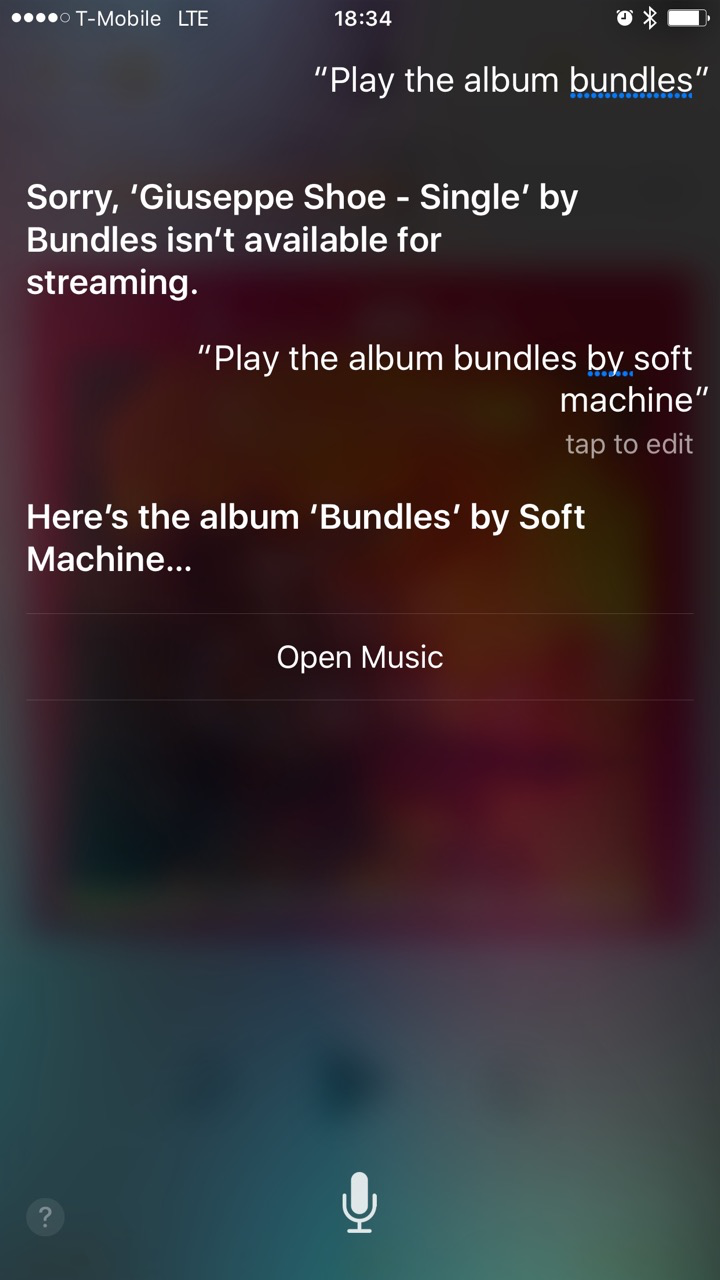
The oldest user interfaces are command-lines — textual dialogs with a system that pedantically interprets everything exactly as you type it, and gives up entirely if you type something it doesn’t understand. They’re gloriously unambiguous, but require you to learn their hyper-precise, utterly unnatural language. In contrast, conversational interfaces like Siri (and Cortana and Google Now) make that compromise the other way around: much more ambiguous, but with almost no special language to learn at all. Just speak your native language! All the pressure of making a computer understand a human is taken off of you and shifted onto the poor designers and engineers. Their first colossal challenge is recognizing your voice — what did you say? Can it hear you in a noisy room? How about if you’re one of the millions of people who mix languages in their daily life, or you want to contact someone with an uncommon name? What if you have an accent? Then, once they’ve got the words they think you said, comes the job of interpreting them — what did you mean?
This is probably an artificial general intelligence problem: the day we finally solve it is probably also the day that we birth a superintelligence that hopefully won’t kill us all. Until then, the best we can do is to put together fuzzy systems that use context and a library of prior knowledge to weight possibilities and ultimately guess what your words probably mean. Anyway, that Siri failure. I figured that asking for the album Bundles would be good enough, considering that I only have one album by that name in my music library. Instead I got a single from an artist I’d never heard of, and it couldn’t even play. What surprised me about the result was how many distinct prioritization steps it seems not to have done:
- Match the type of data I specifically asked for: the album, not the artist. This isn’t even fancy fuzzy logic; it’s just a good old-fashioned database query. When the user generously specifies both the field and the value, use it!
- Prioritize my own data over random data out there in the cloud. I’ve gone to the trouble of adding my favorite music to my iTunes library; it seems that Siri should look for matching results in that generous trove of user-specific meaningful context first.
- Prioritize data that I have an established relationship with. In addition to having them in my personal library, I’ve also told the Apple Music online service that I really like Soft Machine by streaming their music and by hitting the Like button many times. The band called Bundles, on the other hand, I’ve never heard of, let alone listened to in iTunes.
- Prioritize data that is actually available. Even ignoring all of the above, if the first matching result isn’t available to stream, how about continuing until you find something that is?
- Model the metadata that’s important to people who use the data. iTunes doesn’t know the difference between an album and a single, even though it’s a very meaningful distinction for music fans. Instead they encode the nature of the release into the title, tacking on the word “Single”. If the software understood the distinction, it could notice that this “Giuseppe Shoe” release is a single, and I asked for an album, scoring another point in favor of the correct result.
- Recognize the popularity of the data. This should be a last resort, because there are so many delicious bits of context, particular to the user, that should get you to the correct result. A huge benefit of personalized systems is that they can know what you prefer, no matter how common your preferences are. But say if the user asks to hear the song “Hello”, and there’s a super-hot single out just this week by that name? In the absence of any data, play the hot one, not any of the hundreds of other songs out there by that name. Not making any of these prioritizations suggests that what’s actually going on in this system is an old-fashioned, linear, command-line-like process: Do a music search; get the results; pass the first result to the player; if something goes wrong, return an error and give up. But a conversational interface demands a more organic, probabilistic process: Do a search; get the results; weight the results based on context and prior knowledge; try the best match; if something goes wrong, go back and try something else.
Do the Dumb Things I Gotta Do
January 1, 2016
How often do you consciously evaluate the direction of your life? For some folks it’s today, once a year. For a good while my answer was “never”. If I was forced to by some major event, I’d think about where I was headed just long enough to reach a reasonable answer, then get back to fulfilling my active projects.
The project was the coarsest unit of aspiration on my mind — Write a chapter. Ship an app. Give a talk. Learn to play a song. Design a poster. Translate a section of a video game. When I thought of something that seemed worth doing, I’d make a project in OmniFocus. Like maybe if I finished enough projects, good things would happen to me on a bigger scale? Sometimes they did. Sometimes not.
This year, though, has been about consciously steering. I started a periodic review practice, which at first meant “giving myself a pep talk inside an OmniOutliner document every couple months”. After a few, though, a pattern emerged in the way I thought at this bigger scale: the quest. Publish the UX Launchpad Book. Use Time Consciously. Succeed via a Peaceful Mind. Some of these quests might involve projects, but none of them is defined entirely in terms of lists of actions. Instead they’re about how to live.
GTD-style projects are just lists of actions needed to reach a concrete goal. But quests can involve new habits, new ways of seeing and thinking, decisions about which projects to work on, and perfecting how you do those projects. Writing a book means paying more attention to the world. Using time consciously means blocking out events on the calendar to work on projects and pursuits, rather than just hopping from one thing to the next until time runs out for the day. It also means using timers to alternate focus time and break time. Succeeding via a peaceful mind means developing a mindfulness and meditation practice, which I still owe you a letter about.
So every 34 days (I love my nonstandard intervals) I sit down and check in on my quests. For as long as it takes, I write out a review of each one. How is this quest going? Are there systems or practices I can put in place to make it go better? Should it continue being an active quest, or should I consider it completed or abandoned? Have I learned anything that should go into my very special Identity, Rules, or Personal Canon lists, where I enshrine the core notions I intend to live by? This regular ritual, and the systems created and refined by it, are a way to make sure I’m always making progress toward something. That I’m not just flapping about, but improving. Day to day, I can check in to make sure that the ways I’m spending my time and energy are contributing toward some quest or another, and that none of the quests are being neglected.
Write Think Write Write
January 15, 2016
Sketching is the cental activity of design, but it doesn't always have to be sketching pictures. I really like roughing out text outlines to make sense of a complicated problem. In this approach, once you understand what you want to make possible, then you can worry about drawing a picture of it. An approach I've lately found to work well for improving a software experience involves separating the experience (what users see and do) from the mechanism (what is actually going on in the software). It goes like this:
- Write about the old user experience
- Think about the new mechanism
- Write about the new user experience
- Write about the new mechanism
Write about the old user experience
Presumably you're trying to improve the software because there is something wrong with it. What are the problems? What do people want to do that they can't do? What's confusing? Where do people make mistakes? Give up and try another product? Maybe even give up on solving their problem at all? Write it all down.
Think about the new mechanism
Now that you've thought about users, think about your team and your process. You've already got some infrastructure in place; anything you implement must build on that, or at least be careful of the amount of it that you tear out and replace. So think about how you might make the thing work better. Don't commit to writing anything about the mechanism, yet. Just think about it, to put in mind what a realistic solution might look like. A user experience should not expose the underlying mechanisms of the software, but now you've at least considered how the thing might work behind the scenes.
Write about the new user experience
Now write about how it should work for a user. Take each point of confusion or frustration from the old experience, and describe in detail how it should be better in the new one. If you come up with something that doesn't fit with the mechanism you thought of in the previous step, write it down anyway.
Write about the new mechanism
Now you can write technically about how the new thing should actually work. Try to reconcile the new user experience you wrote down with the mechanism you thought of. If they're in conflict, the UX has to win. It's already written down! So try to describe a mechanism that supports the UX, even if you have to adjust it from what you originally imagined. I find Write Think Write Write to be helpful in making sure that you consider how the experence and the technology fit together before deciding what to do, while giving more weight to the experience.
Clammbon 2016 Trip Report
April 7, 2016
This was written for Dramatickers, my fan-site for the band Clammbon. I thought that newsletterfriends might like to read it, too. If you’re in a hurry you can skip to the part at the end where I meet my favorite band and they’re just lovely.
It was certain that I wouldn’t get to Japan this year, and that I’d miss Clammbon’s tour, the one where they were selling the new album that couldn’t be bought in stores. And the signings they were holding at certain shows. And, uh, my brother-in-law’s wedding. But at just about the last moment, several events unexpectedly lined up and a trip actually made sense. We went for it.
Normally for such a tour, I’d try to get a ticket for a show in Tokyo, my home base. But by the time I knew I was traveling, The Club Quattro Shibuya show was sold out. So, plan for a long train ride. Shizuoka? Nagano? The best option ended up being the city of Mito, in Ibaraki prefecture. (It helped, in my meaning-seeking brain, that the city’s name is a homophone for the name of a Clammbon member.) And unlike the Tokyo show, it included a signing! A quick video call to Tokyo; my father-in-law stepped out to the convenience store and came back with a ticket all while while the Skype line was open.
Kichimu
Harada Ikuko owns a cafe in Kichijôji, Tokyo, called Kichimu. Somehow I’d never made a pilgrimage to this place, sure to be special for a true Dramaticker. This time I was determined to do so.
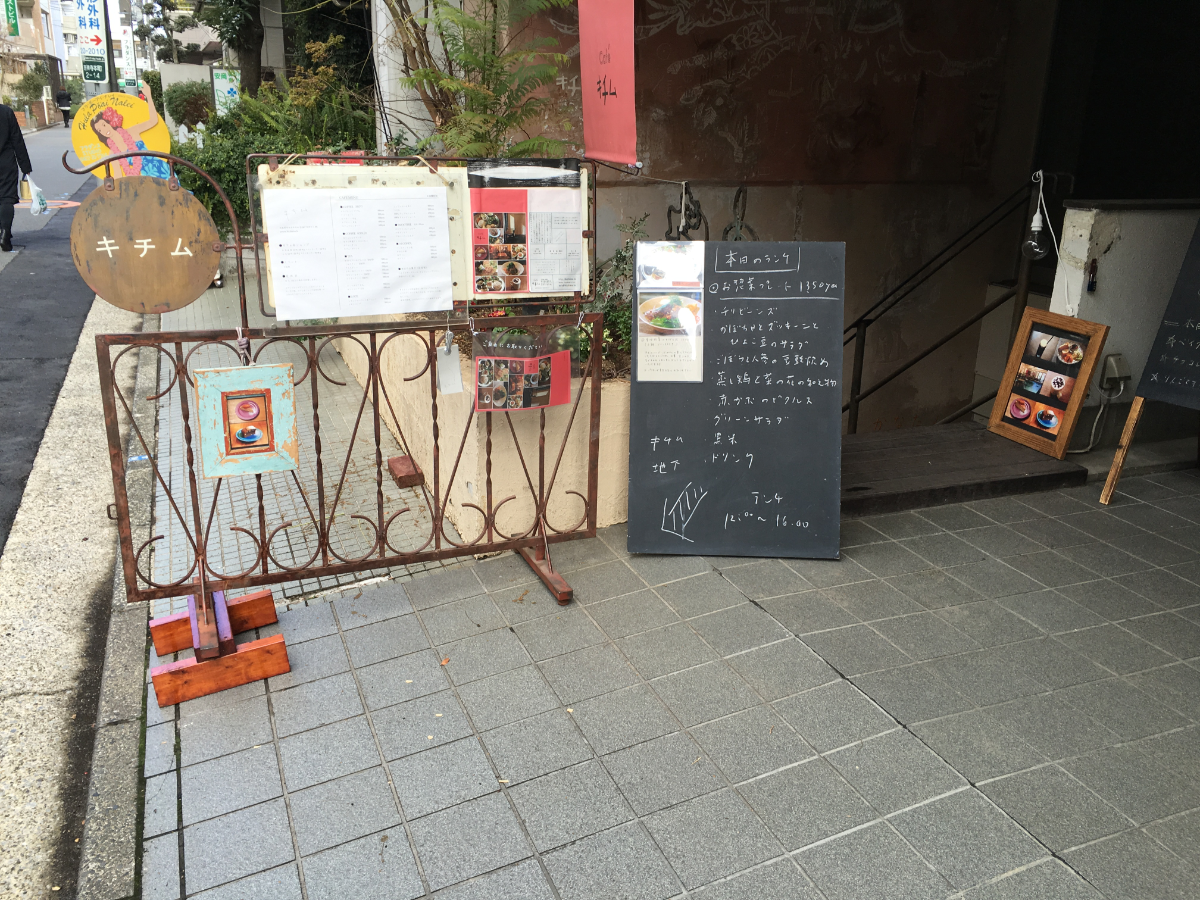
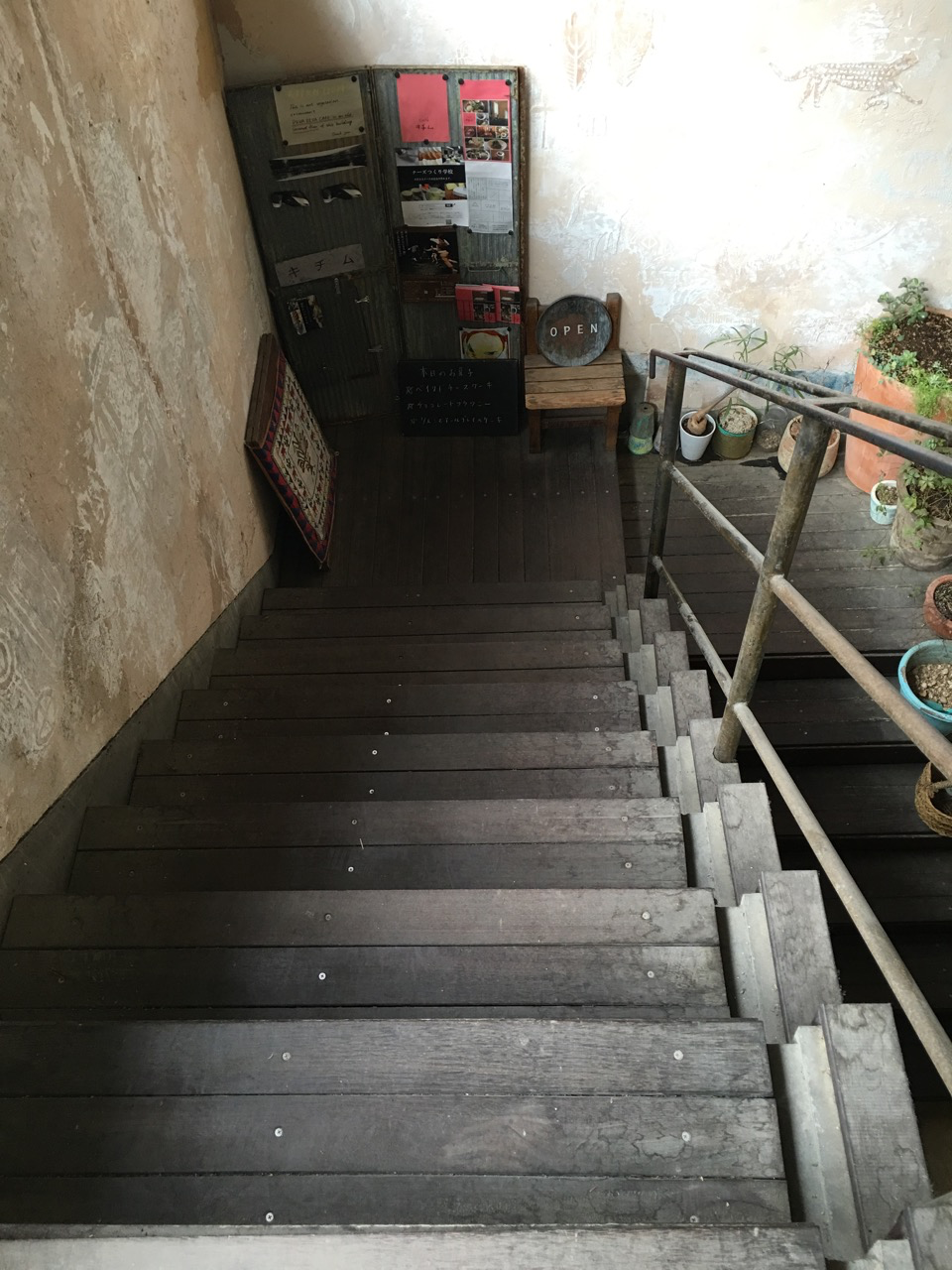
When I sat down in the cafe to await my lunch, I opened my notebook and wrote, “Every surface in this place exudes the playful, peaceful Clammbon spirit.” After my meal, I continued, “That soborodon was one of the best things I ever ate. The piping hot rice, crunchy stuff, peanuts, lime, spicy sauce that they warned me about and then I used it all... I could eat that every day.” Indeed, weeks later, I still find myself craving it.
It was my first full day in Tokyo on this trip, and the last day of the Haruka Nakamura photo exhibit. They were playing his album Ongaku no Aru Fuukei throughout the space, and an area of the cafe was sectioned off with black curtains for the installation.
音楽のある風景 - haruka nakamura PIANO ENSEMBLE (Official MV) from KITCHEN. LABEL on Vimeo.
The exhibit was titled ∞. It featured 88 photos, printed on fabric, suspended in a figure-eight that you duck into and view from the inside. One photo at a time was also projected onto a wall of diaphanous fabric strips. The combination of the translucent photos, ever-changing projected light, and viewers moving through the space made for an ethereal, ever-shifting experience befitting Nakamura’s music.
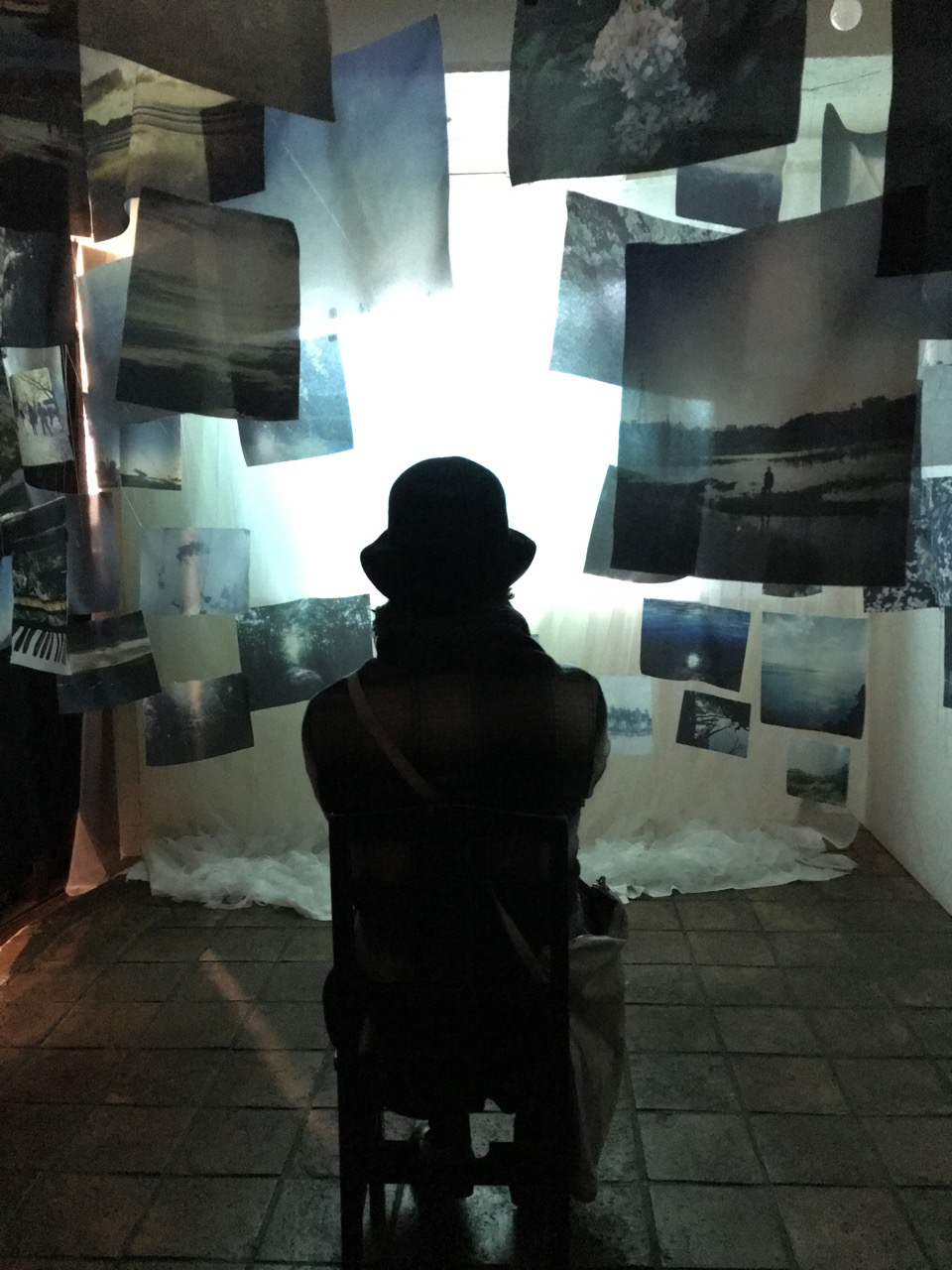
A the front of the cafe is a tiny shop area with a selection of art, jewelry, books, CDs, and so on, all related to or curated by Ms. Ikuko. After carefully scrutinizing every last item, I chose a book collecting the Yamauchi Masumi paintings that Ms. Ikuko has hung from her keyboard over the years, and a set of postcards by Kitamura Norichika.
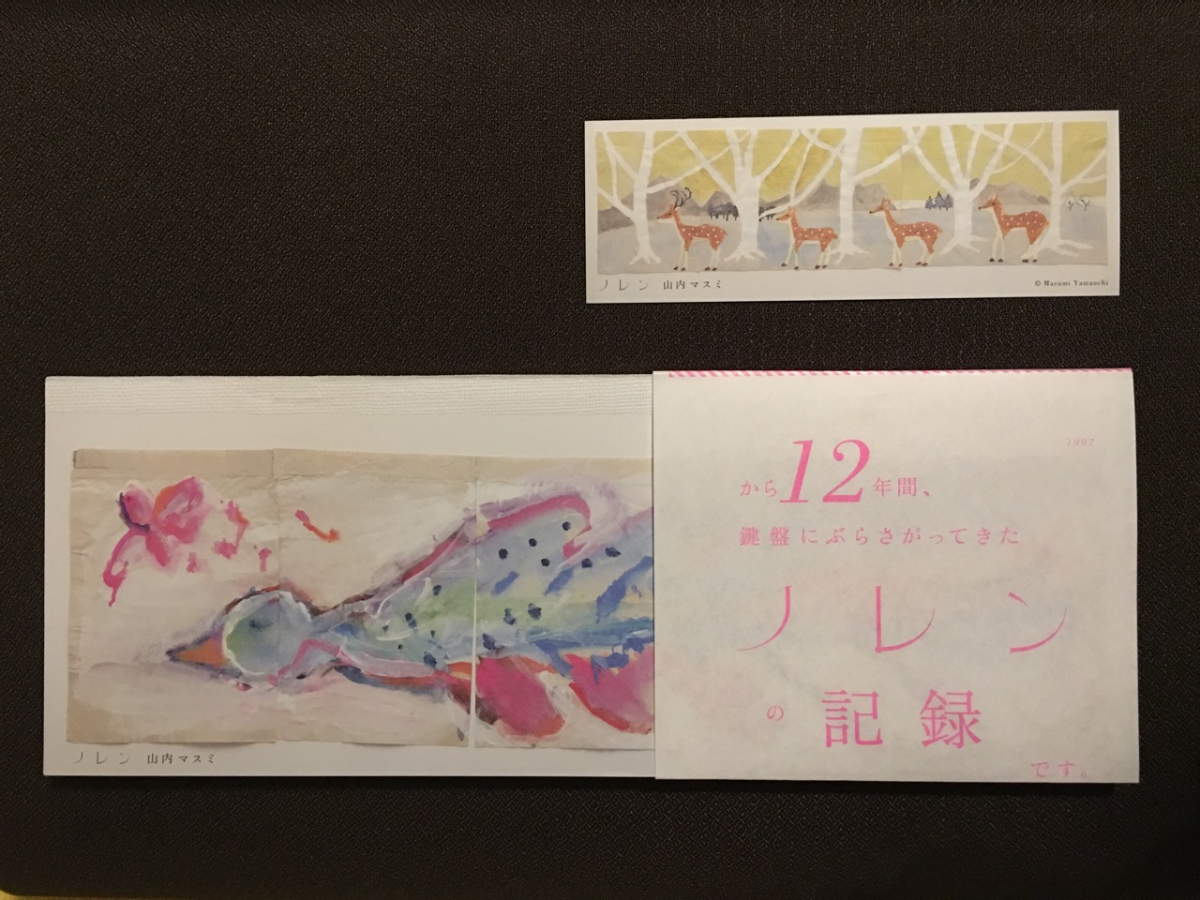
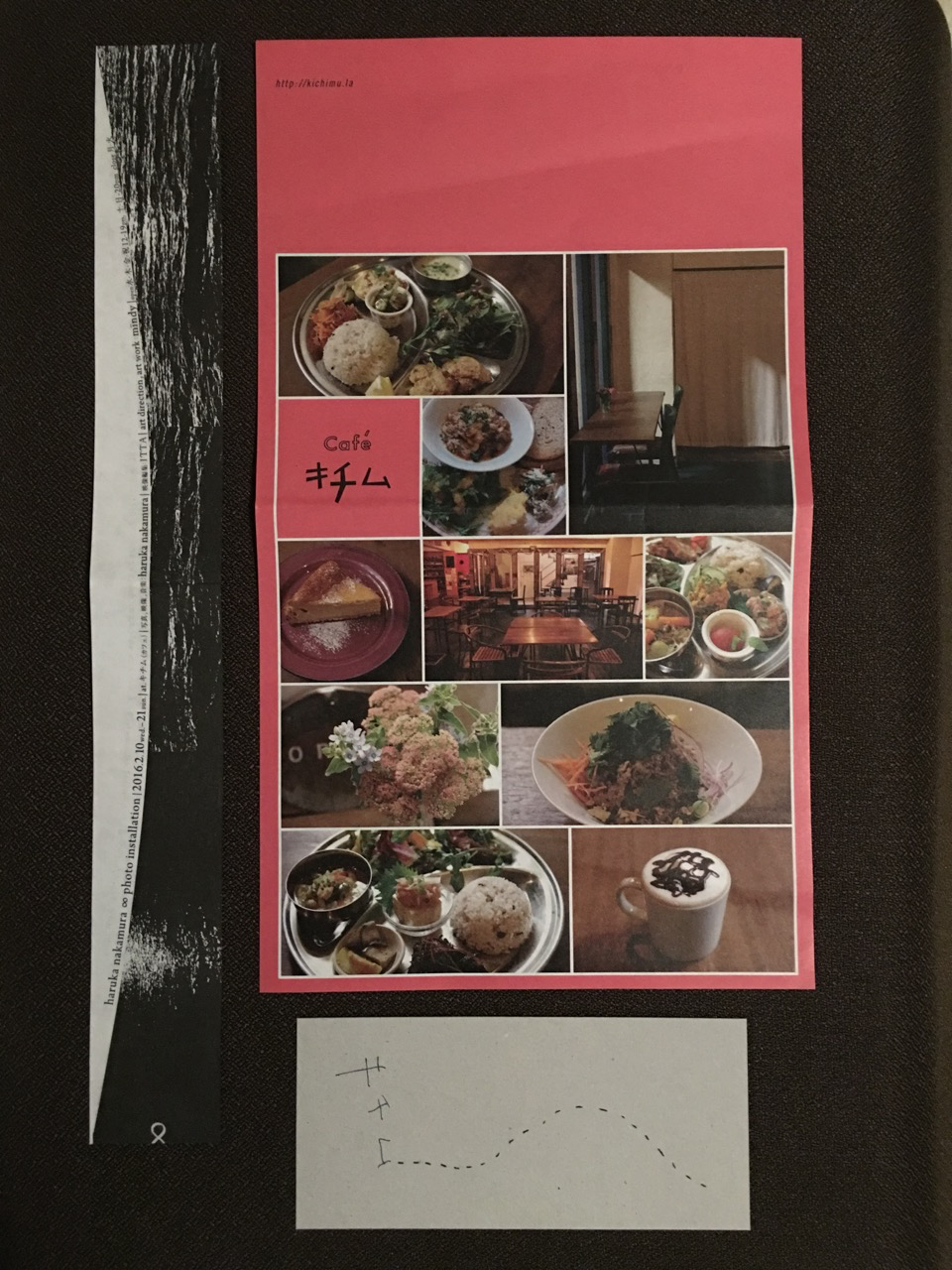
Kichimu Again
I couldn’t stay away. On a free afternoon the following week, with that delicious soborodon still hovering in my mind, I headed back to Kichijôji. The Chûô Rapid Line train took me a stop too far, to Mitaka, but walking one station back seemed like a fun idea. It was — the area between these two stations is just lovely. Tree-lined residential streets, boutiques, galleries, the huge Inokashira Park, and even the Ghibli Museum. It all has a more artsy and cheerful feel to it than other upscale neighborhoods like, say, Daikanyama.
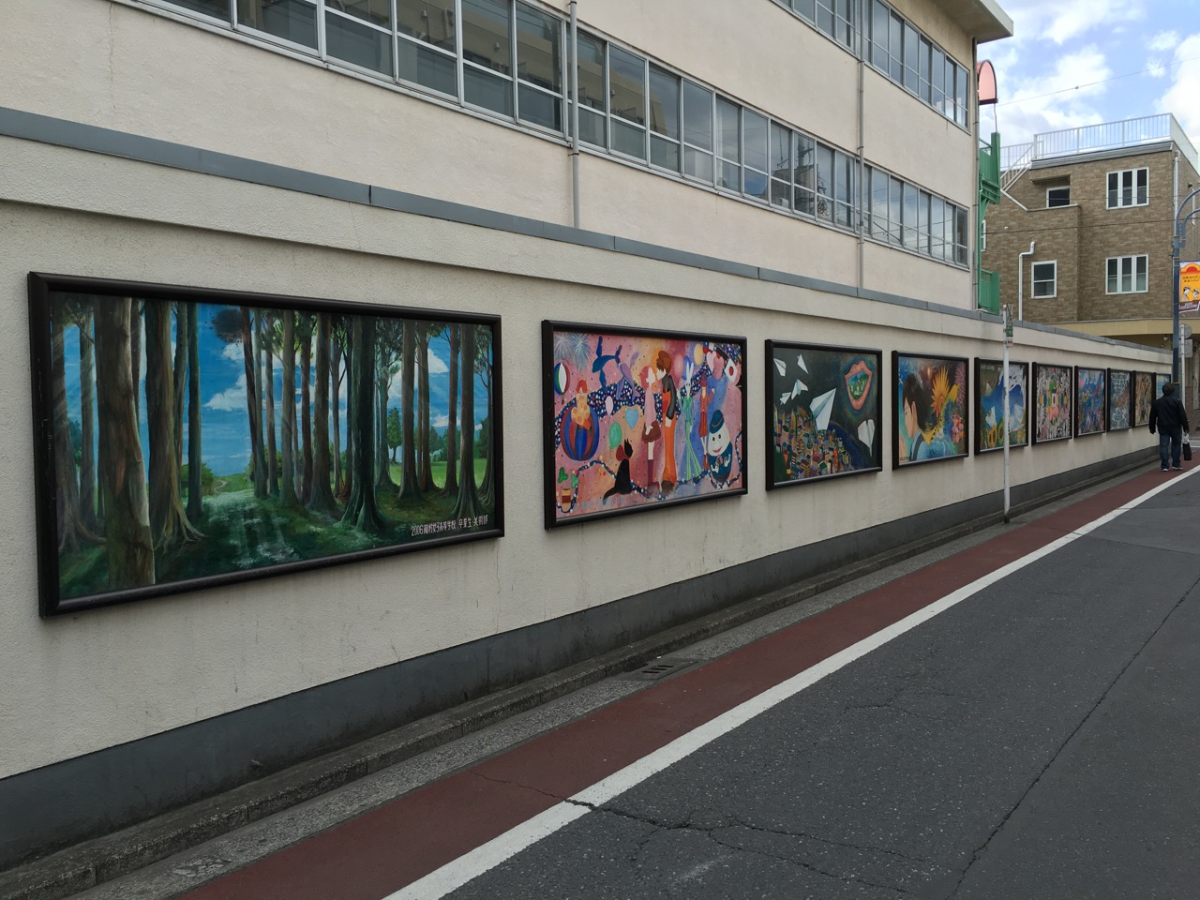
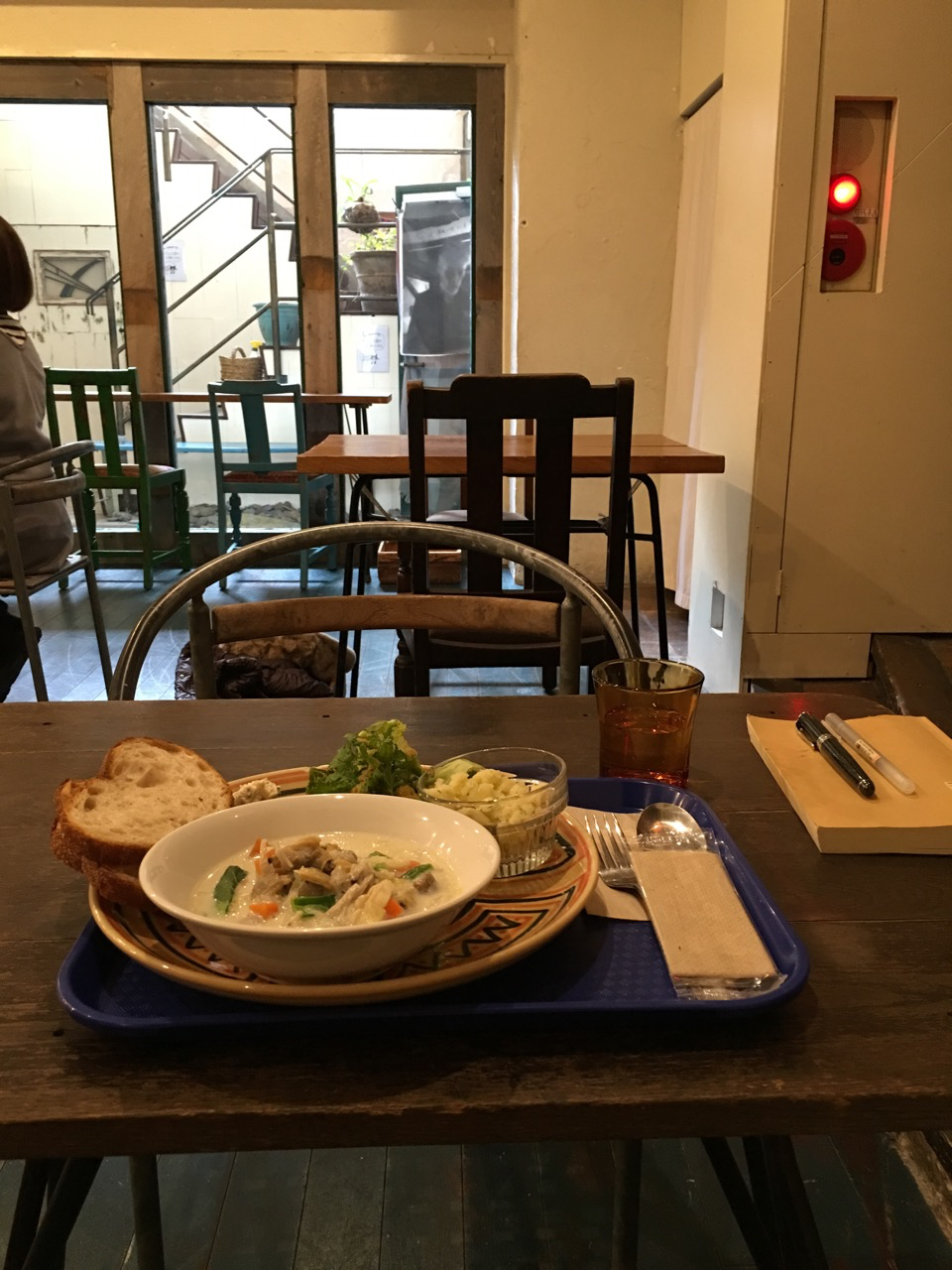
Kichimu is a small operation focused on inventive dishes with fresh, local ingredients, much like hip cafes on the American west coast. The menu is small and always changing. So on my second visit I learned that they only offer the soborodon on weekends, and instead all they had was a clam chowder. That was lovely, too, served with salad, potatoes, bread, and a rich spread. (By the time I realized that the spread was not a dish of its own, I had already eaten the bread. I ate it with the potatoes instead and it was great that way, too.)
This time, on my way out I discovered the little library table. It’s populated by books from Ms. Ikuko’s personal collection, which patrons are encouraged to pick up and read while they are in the cafe. Magazines, novels, nonfiction, art, and so on. I stood and read a Mito interview, about how he got into progressive rock and Five Star Stories, in a special Clammbon issue of Eureka. (His reason was the same as mine: used prog-rock LPs were cheap when he was a kid!)
On this second visit, the music selection was raw, rootsy folk standards. I discovered from a sign on the wall that for the entirety of 2016, apart from special events like the Nakamura exhibition, music in the cafe was selected by the band Tenniscoats. This about knocked me over because just a few days earlier I’d discovered (and met) Tenniscoats at their very intimate collaboration concert with Aoba Ichiko. That show was a very special experience indeed, and a story for another time.
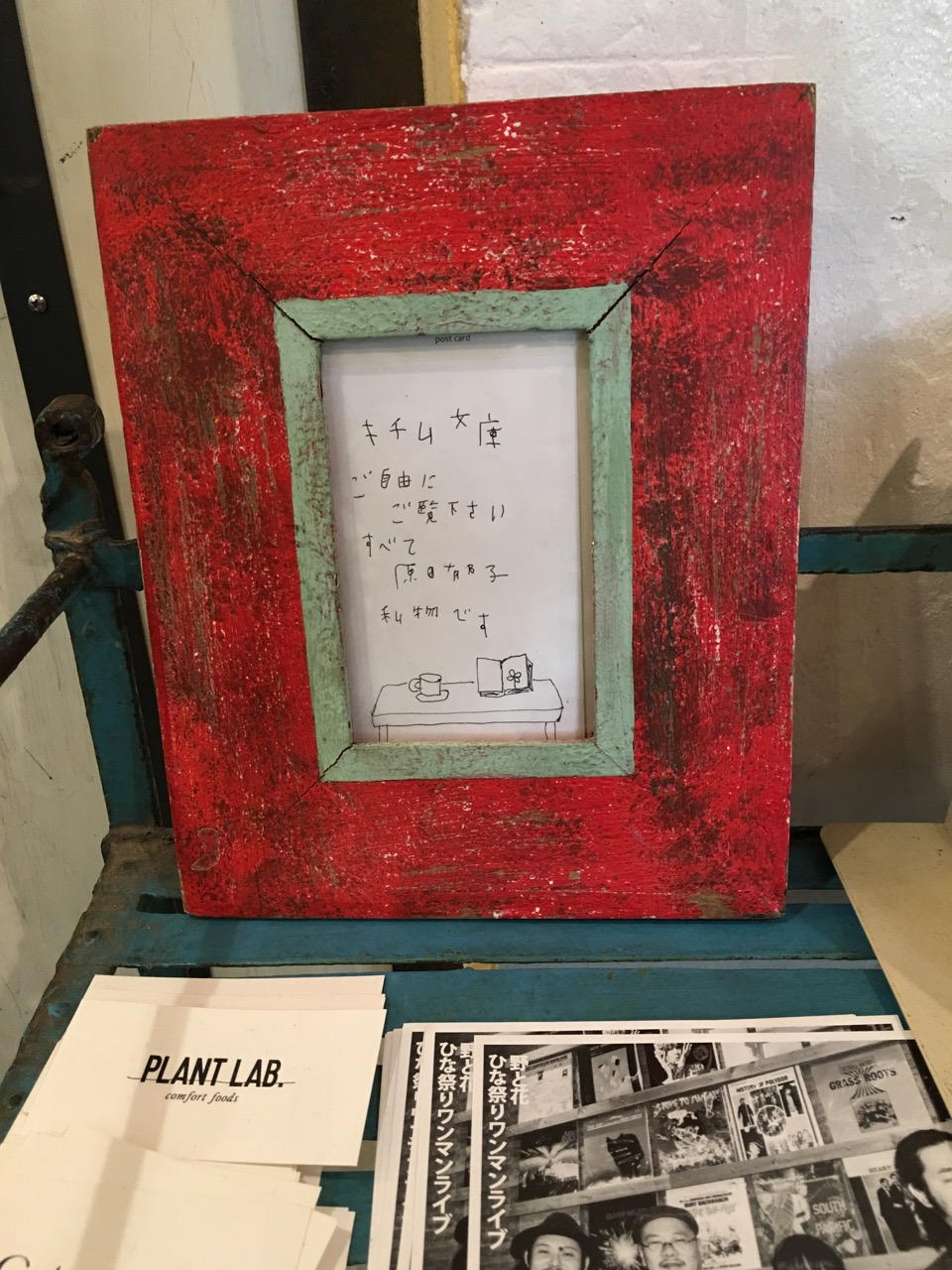
Desperado
When in Shibuya to meet up with a friend, I did make my regular trip to Desperado to see if there was any Spoken Words Project. The excellently-attired fellow there advised me that all they had was one dress, and that they were expecting new pieces soon. He was curious how I knew of the label, so I explained the connection to Clammbon and to Harada Ikuko.
Clammbon at Light House Mito, March 4 2016
The cushy, 100-minute Hitachi-gou express train took me from Tokyo to Mito, the capital city of Ibaraki prefecture, on the day of the concert. I had most of the day to explore the city, and I came to love its micro-Tokyo charm. (You can wander Mito with me on Instagram.) The merchandise tables opened at 17:00, outside the venue — an important detail on this particular tour. Clammbon is experimenting with an increasingly self-contained and self-sustaining business, to the point that their latest CD, Moment, is available at concert merchandise tables but not at record stores nor on the internet.
I withdrew some extra cash at the 7-11 on the corner, a comically simple process compared to the ordeal it used to be to get cash from a foreign account in Japan. The staff confirmed that I could buy as many copies of the CD as I liked, so I picked up one for myself and three for friends. Plus a T-shirt designed by Ka na ta, a brand that the band has been wearing on stage lately and that has a showroom at Kichimu.
Audients waited outside in the cold, around one of the city's several statues of the legendary feudal lord Mito Kômon, and were let into the standing-only venue one by one according to the letter and number on our tickets. The staff person called out A1, A2… up to A150, then B1, B2, et cetera. My ticket was… C117. Quite close to the end of the 350-person capacity. But a lot of people had gone up to the balcony, and near the back of the floor was still quite close to the stage indeed.
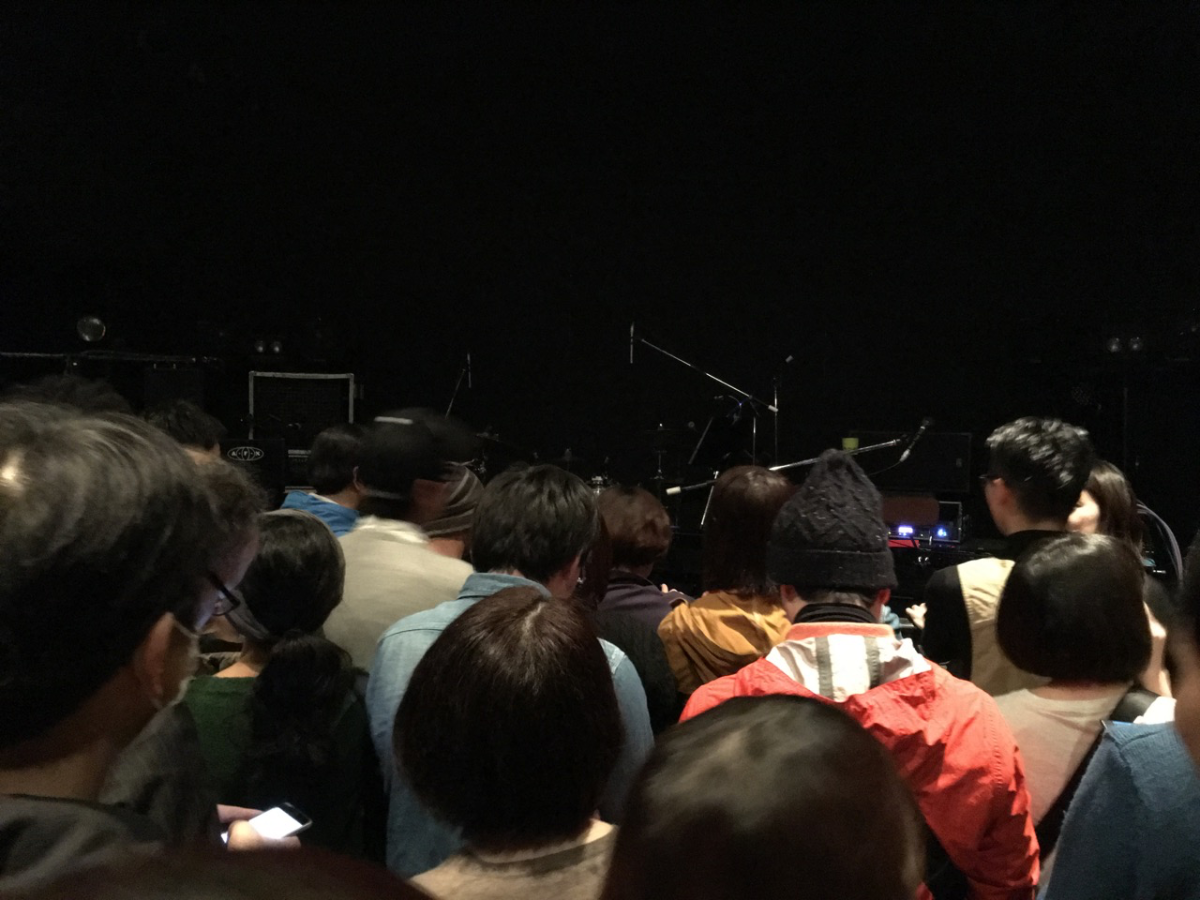
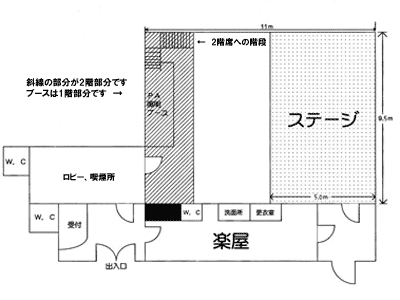
Floor plan from Light House Mito official site
We were really crammed in there. Several times the staff asked us to all take a step forward, when we were all already closer together than if we’d been on a rush hour Yamanote Line train. Within minutes it was sweaty hot. Once the lights went down and Clammbon took the stage, Mito high-fiving Mito, of course nobody cared.
Set List
- Surround
- GOOD TIME MUSIC
- Re-Mellotron
- (First chat)
- Kisetsu
- Filament
- Flight!
- yet
- KANADE DANCE
- Chicago
- Re-Aru Kodou
- (Encore break, second chat)
- Musubi no Uta
- Slight Slight
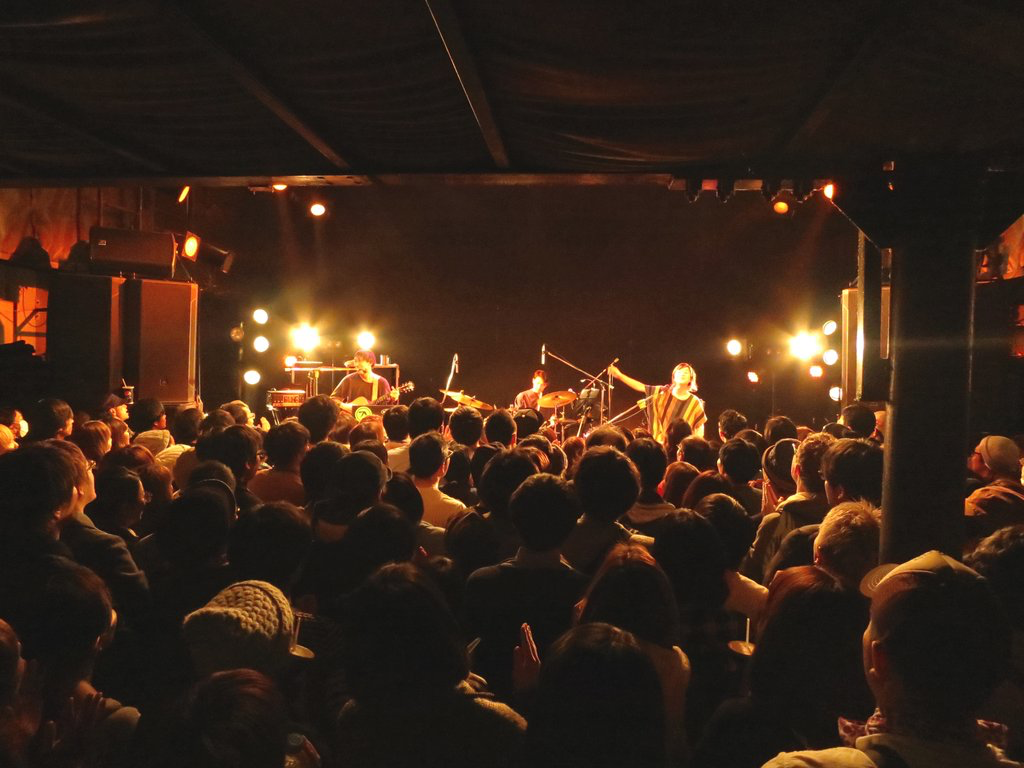
Official photo from Tropical. I’m visible on the right!
For a few favorites — “Surround”, “GOOD TIME MUSIC”, “Chicago”, and “Re-Aru Kodou”, I believe — the audience was lit so that the band could see and interact with them, just inches away. The first words that Clammbon had to say to us were from Ikuko: 近い。どこ見ればいい?慣れよう。 — “So close! Where am I supposed to look? I have to get used to this.” Several times it felt like Mito or Ikuko was smiling directly at me, absorbing my enthusiasm. Were they really…?
“Re-Mellotron” was a first for this tour, and the one unusual choice considering its theme of January snow. “Yet” was the sole song from triology, though I’d been hoping to hear “Agitator”. “KANADE DANCE” served its usual role as a sort of centerpiece. And the set included the entirety of the new EP, Moment.
In the spirit of getting closer to their fans, The band spent a lot of time chatting with the audience. After some banter about the intonation of Mito the musician versus Mito the city, the first chat session was largely about their experience in the music business and their experiments with opting out of the normal way of doing things.
Mito gave a breakdown of where the retail price of a major-label CD goes — recording, marketing, manufacturing, distribution, sales, &c.… In the end the artist gets 5%. But after 20 years of building their business, Clammbon can do a lot of that themselves. They can record at their own studio. They already have dedicated fans, and their side projects get their names in articles and on TV, so there's no need for the big marketing budget. (Mito does a lot of anime music, Daisuke is teaching, and Ikuko does commercials.) And instead of selling in record stores, why not bring the CDs along and sell them at the shows, if they’re touring across the country anyway?
Ikuko likened the model to farm-bought produce. She loves lotus root (Mito: "Last time it was carrots!") and she found that she could get it fresher and cheaper by buying it at the farm. Plus the bonus of seeing the place it came from and meeting the people who grew it. A big part of the idea is for people to come to the show, hear the fresh new songs, and if they liked them, buy the new CD.
The model seems to be working — the farm-direct Moment has made as much profit as if it had hit (I believe) #4 on the Oricon chart! In contrast, triology reached #13, and Clammbon’s highest chart position ever was #11, for 2010. Where does all that money go? Mainly back into the music: high-end equipment, studio space, &c.
The second chat session was about finding more places to sell the CDs. At first the idea was that they’d be for sale only at venues on the day of a concert. But over time local businesses — cafes, restaurants, clothing shops, galleries, and even a few record stores — have been carrying it too. There were survey forms at the show, with fans invited to submit ideas of eclectic places that might be willing to sell the CD. Lately the official Clammbon Twitter account has been overflowing with announcements of shops carrying the album. Mito joked that maybe they should have called this the “Where Shall We Sell” tour, in the spirit of their past “Where Shall We Play” tours.
Clammbon had recently written and recorded the ending theme for the new Shinkai Makoto anime She and Her Cat, which Mito explained that they couldn’t play live yet, because it was just airing for the first time later that night. One audient informed Ikuko that it wouldn’t actually air in Ibaraki until two days later, so we couldn’t go home and watch it just yet.
It was a little strange for the encore to consist of two new songs, and for there to be no “Vital Sign”, but it was important to the band to play us the entirety of their new CD so that we could judge for ourselves whether to buy it. Plus, time was limited as there was still a signing to do! The new songs were captivating, and covered a wide range of styles and instrumentation. The audience was just as enthusiastic for this new and unfamiliar material as we were for the old favorites.
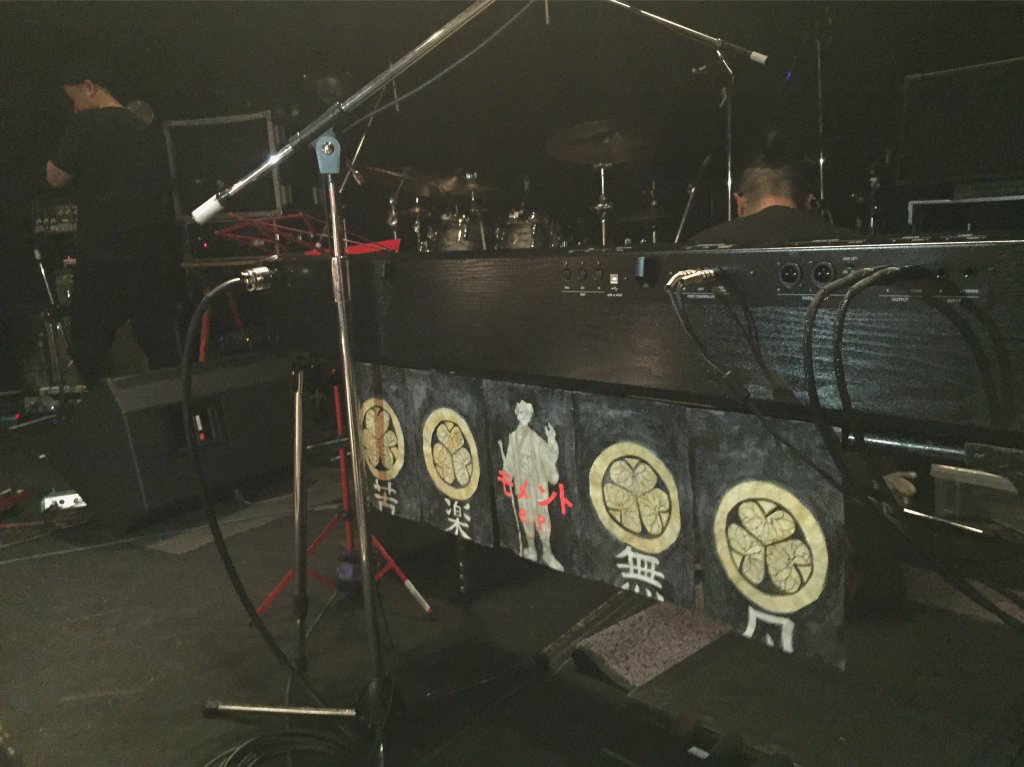
A very special Mito Kômon noren for Ikuko’s keyboard, by Yamauchi Masumi. Photo by @tsubametachi.
For the signing, everyone was sent back outside. This was a perfect time to redeem the mandatory drink ticket you paid ¥500 for on the way in, but didn’t have time to redeem while rushing to get a good spot. A cold Yebisu under the statue of Mito Kômon was just the thing to cool down from that sweaty room. Anyone who bought merchandise and had a ticket to the show was given a card with a number on it; another number-calling ritual began.
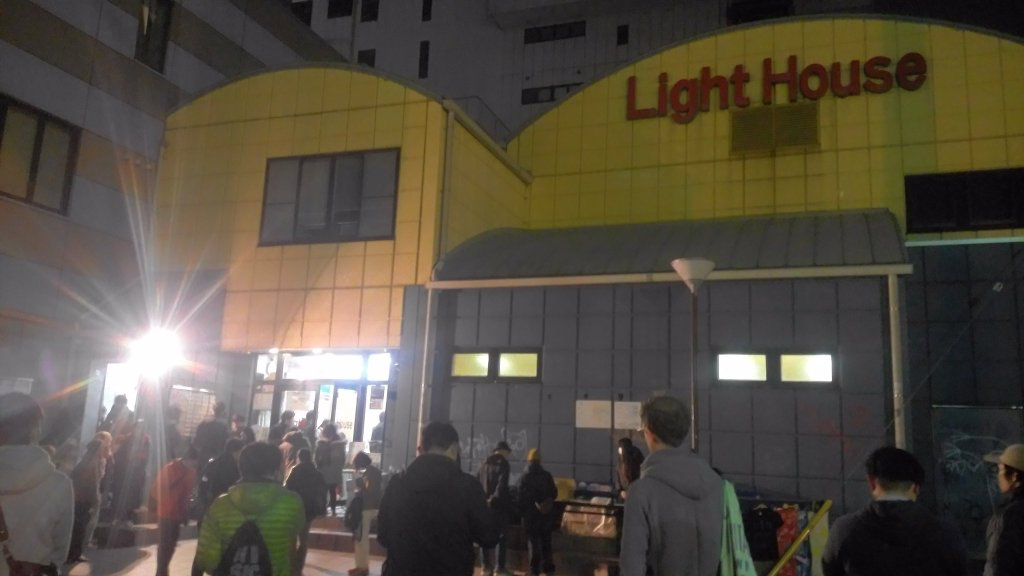
Photo of fans waiting for the signing (including me!) by @Ruby_S_Arms
My number — 92, I think — was called. I went. Just inside was a little table, and Clammbon was there. Sitting here in my bed in the USA now, typing this on my phone, my mind stumbles, trying to believe it. But I have the memories. I have the tweets. And of course I have the autographs.
First was Mito. He about fell over when he saw my Dramatickers shirt.
(The following exchanges all took place in Japanese, of course.)
“Your shirt! That’s amazing!”
“Is it!?”
“Dramatickers, huh? Wow!”
“Yeah! It’s from 2002, Shinjuku, at Liquid Room.”
“2002, wow. Liquid Room… it must have been with Toe?”
“With Rovo, actually.”
“Rovo! Right. Well, thank you very much for coming out.”
“Thank you.”
Mito shook my hand briefly, then angled around for a strong homie handshake, while delivering another impassioned “thank you.”
Daisuke, as expected, was reserved. He signed, shook hands, and said a sincere “thank you.”
Ikuko greeted me with a huge, excited smile and wiggle, as if she’d been surprised at work by an old friend.
“Dramatickers!”
“Haha, yep!”
“That’s great. I was watching you.” She pointed to her eyes and then to me.
“You were?”
“I saw you singing.” She flapped her hand like a puppet.
“I was.”
As she drew the little character that serves as her autograph, I added, “That’s cute!”
She gave me a smile and a handshake, and said, “Let’s meet again.”
That was it. My dumbfounded banter may have been weak, but the atmosphere was of gratitude and joy. The band made an effort to make everyone feel welcome and appreciated, and every face was smiling. And while I didn’t want to slow down the line by talking about this site, it was gratifying to have been seen and acknowledged, to know I’d made a small impression. Perhaps when I write in to request consideration for foreign fans as they develop their direct business model, I can mention that I was the foreign fan in the classic shirt at Mito, and they’ll remember. That would be nice.
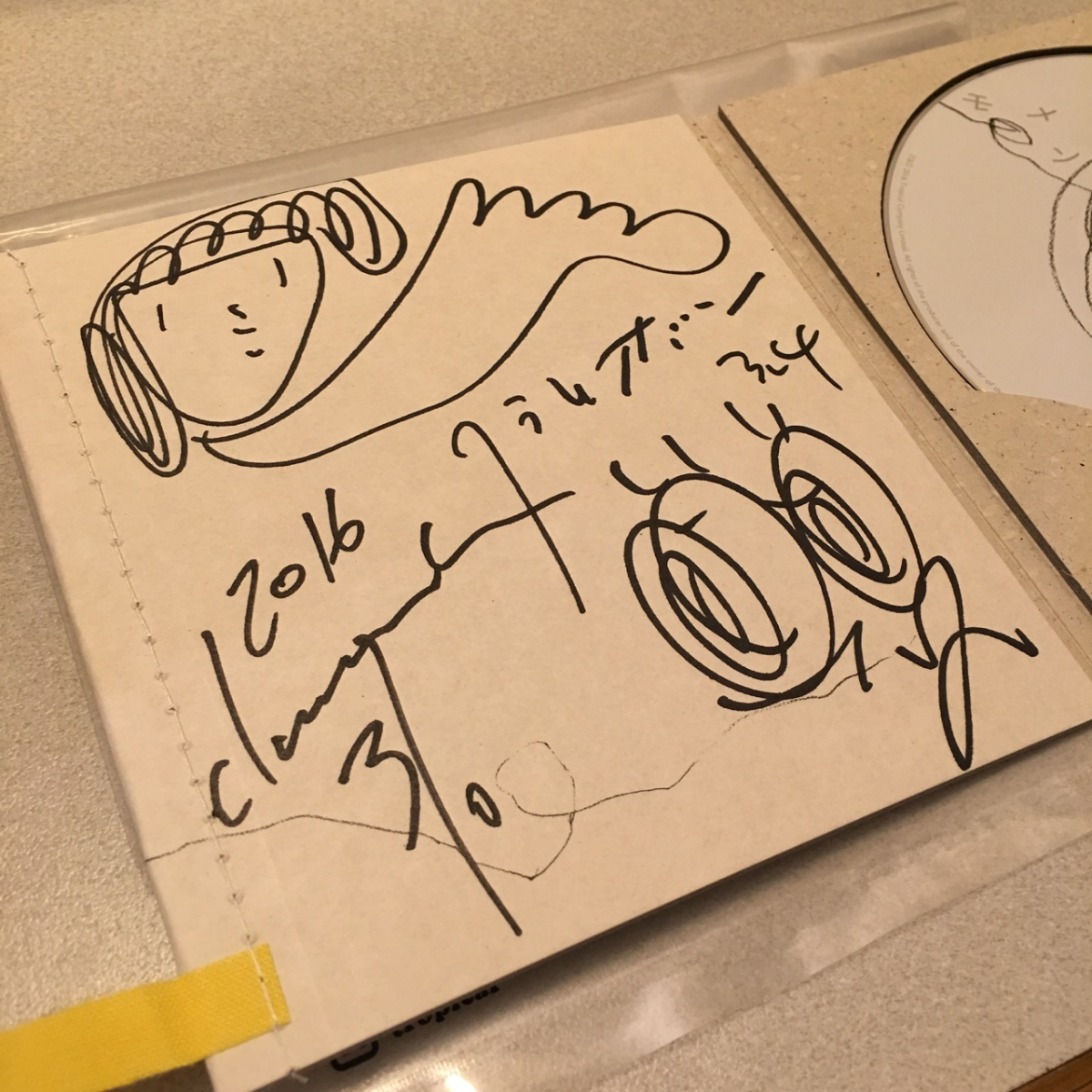
Chûkasoba Suzuki
Mito’s love for noodles is well-known; he appears at various ramen establishments in the band documentaries and on social media, sampling each city’s best offerings over the course of a tour. When during a chat session he mentioned that he’d been to a place called Chûkasoba Suzuki that day, the crowd murmured approval. So the next day I hunted it down.
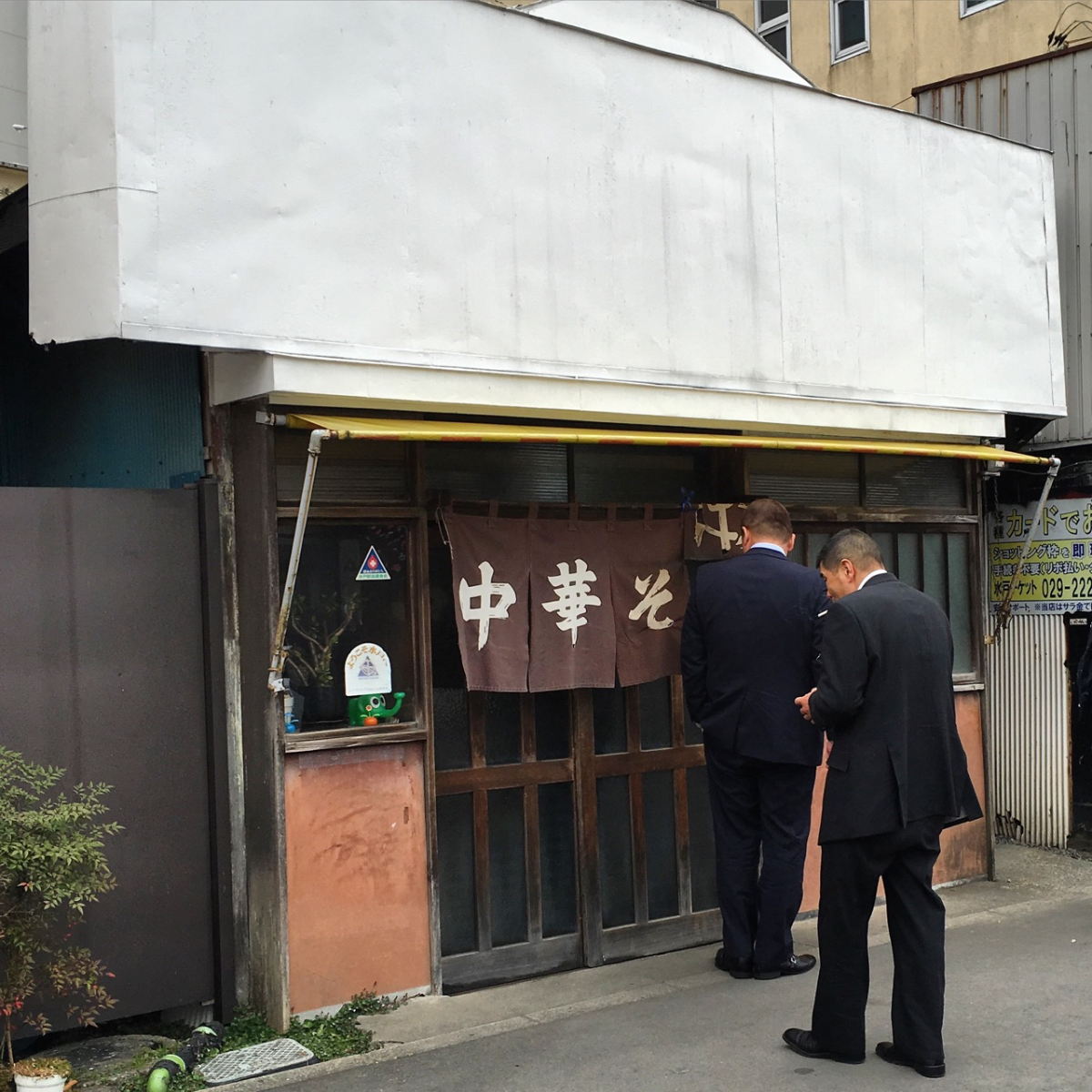
The place is barely labeled; just a fabric drape in front of the doors that says 中華そば — “Chinese noodles”. I gathered the courage to go inside, where a woman who very well could have been there since the place’s founding in 1960, said, ラーメンしかないけどそれでいい? — “All we have is ramen, you want some?” I agreed and sat at a tiny table, surrounded by patrons of advanced age slurping their noodles and saying nothing. A man gave me a nudge and quietly encouraged me to use the stool at his table to set down my bag. Eventually my ramen showed up: the most standard, classic bowl of it you can imagine.

It tasted perfectly ordinary. I brought the bowl to the lady when I was done, as I had seen others do. She accepted it and unceremoniously asked me for ¥250, about $2.25. I handed her the coins, which she took with one hand while stirring a pot with the other. It was an experience to remember. But it was not especially filling. Ninety minutes later I had a big bowl of shio châshûmen at Ajihei.
おやすみなさい
June 17, 2016
In February I had an evening that made me think, as long as I can experience something like this at least once per year, then life is going well. It's been hard to write about, for fear of disenchanting the preternatural memory. But I did it.
Here's the Story About the Evening I Had
Tokyo; Daikanyama. A shmancier area than I am used to, where I stumble across the impossibly hip T-Site bookstore complex.
Dinner: Matsuya. A humble ¥520 beef bowl topped with kimchi, to offset the upscale areas I’ve been wandering. Nearly showtime. Deep underground to the hall outside the venue, where fans pass around a plastic bag full of plastic bags, to put our shoes in.
Inside, tatami. Lit dimly by hanging bubble-wrap jellyfish, around a cluster of clutter in the middle of the small room — a couple of low chairs, guitars, toy pianos, a bucket of markers, a stuffed frog…
A bar. The tender helps me choose a sake to fill my masu, a wooden vessel made of fragrant hinoki and decorated with a drawing by Aoba Ichiko, tonight’s star.
Quietly waiting. Just being surrounded by people who chose to be in that place on that night, sitting on the floor, patiently reading novels (I choose Umberto Eco), murmuring to friends, just being.
No fanfare. Aoba Ichiko and her guests Tenniscoats (Saya and Ueno) walk out into the middle of the room, surrounded by about eighty people, and sit.
Three feet. I could reach out and tap Ichiko on the shoulder as she plays her guitar or operates the weird plastic music note toy that makes scratchy electronic noises.
Playful Ichiko. She makes music by blowing bubbles in her sake; draws a picture of Saya and Ueno, aiming the microphone at the squeaky marker sounds; turns every song into a little improvisational game.
Restless Saya. She hits every object around her for percussion; wanders about the room singing nonsense and absently playing her melodica; ventures away into the adjacent room to sit at a piano.
Taciturn Ueno. He spends most of the show diligently bent over his guitar, building a sturdy skeleton for every song; begrudgingly shares the lyrics to an unfinished song about New York; indulges in a comically extravagant solo that derails the song that spawned it; everyone laughs.
That room. Isolated from everything, the rare feeling of being truly apart from the world and outside of time.
Intermission comes. The woman next to me admires the drawing Ichiko has cast to the floor; I agree and a conversation begins; I've made a friend for the evening.
Sake, CDs. Back from my trip up to the bar and the merch table, I chat with my new friend until the musicians return.
Saya improvises. 「君の眼鏡」, “Your glasses”, she sings directly to me, to begin a song comprising a list of disparate images.
Ichiko follows. 「君のマスク」, “Your mask”, she sings to an audient with a cold.
It continues. The performance feels more and more inclusive, a night with friends.
We cry. At one point Saya has us all with our eyes closed for a particularly mournful song.
We laugh. Many times do we laugh, at unexpected moments, genuinely playing along.
Suddenly, English. Saya switches languages in the middle of a song; I assume this is just how the lyrics go.
The frog. The little stuffed frog, when turned on, repeats your words back to you in a funny voice.
It sings. The frog becomes a part of the band, repeating Saya's voice, Ichiko's voice, Ueno's guitar, the audience's laughter.
It ends. The frog remains, stuttering applause among a tableau of clutter.
Murmurs, photos. Everyone wants to capture the scene of scattered instruments and bric-a-brac that somehow perfectly encompass the feeling of being there; I find that I just want to linger in that sacred space as long as I can.
Then, Saya. I turn around and she's just there, amused, and we get to talking; 「日本語通じます?」, “you understand Japanese?”
I do. She'd changed the lyrics on my behalf, in case I didn't; I appreciate that.
Then Ichiko. She shakes my hand and says, 「おやすみなさい」, “good night.”
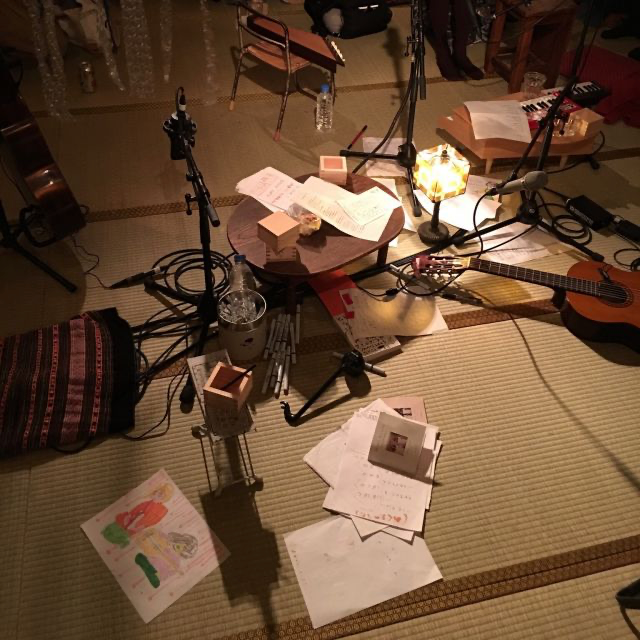
Habit
January 3, 2017
Routine and habit are, I believe, the only reliable tools for improving yourself and your situation. I think they tried to convince me of this in grade school, but it didn't work. Someone recognized the power of this idea and thought, we need to make sure kids get this! If we equip them with the power of good habits, we'll empower an entire generation to reach their true potential! (I spent a long time at war with the word potential, urgh.) So they put on some video or something, saying that if we develop good habits then we can'¦ eat healthy and get good grades, or some other message that I immediately forgot because it was irrelevant to my juvenile psyche. It really meant nothing to me. What they should have said to get that crucial lesson across was something like, 'every single person you think is cool got that way by regularly doing things that made them a better person, whether they felt like it in the moment or not. INCLUDING GEDDY LEE.’
Balanced Values
February 26, 2017
What are your values? Yours individually, and those of your organizations and projects? I think identifying values works best if you can phrase both the value and its opposite as positives. Stated values should help you make decisions. Saying that you value "making great stuff" is meaningless, because it'll never help you choose one course of action over another. Nobody would ever wonder, "hmm, should I make this thing great? or awful?" But! If you say you value "sweating the details", as opposed to "moving fast and breaking things", now you're getting somewhere. You've identified and come to terms with the trade you're making. "Patience" alone isn't helpful, but "Patience over alacrity" (or vice versa!) is. Consistency versus flexibility. Wit versus sobriety. Maybe you choose different ones in different contexts. Now you're thinking on another level ' not just how to be good, but what makes your implementation of good different from someone else's. Making decisions this way, alone or in an organization, feels to me like my brane is growing up.
Wave Existence
March 4, 2017
How important do you think it is to be consistent? I think I assumed for a long time that of course a person should remain more or less the same person all of the time.
But! Walt Whitman:
Do I contradict myself?
Very well then I contradict myself,
(I am large, I contain multitudes.)
When something changes in yourself, it’s easy to think that you’re somehow “off” from normal. You write every day or you don’t feel like writing at all; your interests wander; your outward expression gets more or less colorful; your day to day mood rises or falls; you go from joyful to cynical and back again; your productivity trades places with your diversion; you venture into, or retreat from, social life.
I’ve come to find this exciting. Everything about you can ride a wave, and every wave can have different frequency and amplitude. These aspects of your personality move in and out of phase, sometimes correlating and sometimes diverging, like a neverending Phil Collins drum fill. Or like periodic cicadas, or I dunno, the background on my web site. So you’re never the same person twice, but you’re consistently a product of the same ranges of many values playing against each other. (I have a teammate at work who recognized that she operates seasonally, with certain patterns of thought and behavior depending on the time of year.)
What a wonderful thing it is to see and accept that even if you trace a single big curve at the furthest zoom level, you can wiggle around quite a bit on the way.
Our Mathemindful Universe
April 10, 2017
Do you meditate? I used to associate the practice with certain spiritual traditions or worldviews, and I got some moderately useful advice from books like The Zen Commandments and Waking Up. But I didn’t really develop a successful practice of my own until I read a certain theoretical cosmology book. Yeah! Our Mathematical Universe by Max Tegmark is unequivocally the most interesting book I have ever read. It’s a survey and synthesis of various multiverse theories — like, ideas about our universe not being the only one — and it posits the exhilaratingly wacky claim that these theories might all be true, all at the same time. It also puts forth the Level IV Multiverse (or “Ultimate Ensemble”) theory, which is the only satisfying explanation I have encountered for why anything exists at all and why we find ourselves in this particular existence. I won’t spoil it tho, in case you want the full experience of reading the history and arguments that build up to the theory. In any case: the book introduced me to a weirdly enlightening stratified way of thinking about the world and my place in it. I found that if I focused on these ideas carefully, I experienced something like what I’d always heard about effective meditation! A feeling of vastly zoomed-out perspective, oneness with the universe, calm in spite of petty day-to-day stresses, &c. Here’s how it works for me. I start with the familiar and mundane, then contemplate each stratum one at a time, in this increasingly profound order:
- I am fet. I have a personality and some worries and some interests and I have done a variety of things in the world. Tomorrow I have to give a presentation at work and I hope it goes fine.
- I am a person. I can perceive and think and plan and have an impact on the world.
- I am a human being. I come from a big messy gene pool of humans that branched all over the planet and somehow via an infinite number of accidents some of them survived and propagated themselves to now.
- I am cells. Feeling like a unified being is fine but in a very real way I’m just a colossal colony of trillions of cells that replicated into this shape and that follow these behavior patterns because it’s a weirdly effective survival strategy.
- I am atoms. Sure, cells are a thing but they’re not really that smart; they’re really just clumps of molecules and atoms obeying the laws of chemistry.
- I am a four-dimensional braid pattern. It feels like I’m moving through time but that’s just a convenient way of perceiving things; it’s just as valid to see everything as still and time-free, stretched out into a fourth dimension according to very ordinary laws.
- I am math. Ultimately the shapes of these four-dimensional patterns is pure mathematics, a coherent and internally consistent system just sitting there being itself and processing information.
- “Consciousness is the way information feels when being processed in certain complex ways.” BONUS ROUND: If any of the multiverses are real, then there are certainly an infinite number of instances of you. Instances who are in precisely the same situation as you, identical in every way; instances who made every other conceivable choice, and instances who lived in every other conceivable circumstance. You can’t literally have a conversation with them, of course, but it’s oddly comforting to think that they are out there, living their alternate realities, thinking about you too.
Sekai Caravaggio Aruki
April 24, 2017
Celebrating Inbox Zero by lying on the couch listening to Curtain Call by haruka nakamura, I imagined a video documentary series about historical figures. Do it completely straight-faced, with no explanation of why Caravaggio is unperturbed by a camera crew watching him work on The Denial of St. Peter and interviewing him in between painting sessions. (Especially because now that I think of it, the fellow was in a pretty dire situation at the time.) Get an actor to completely become the subject — an impeccable, historically defensible portrayal. Do everything at half the pace people expect from TV, kind of like Sekai Neko Aruki, “Walking the World with Cats”. Editing that makes you calmer and calmer with each cut. Actually, make it as much like that show as possible — except we’re following historical artists, scholars, and divines around instead of cats. I’d like to watch that.
Hanging out with Darwin
March 13, 2018
So we had a child. Two months in, I have a lot of feelings and hopes and thoughts about that. If you want the cute photos and sentimentality, I can add you to the Facebook group. If you want philosophy, read this letter!
It’s remarkable how wise this tiny creature seems. Sometimes I really get the sense he knows things that I don’t. I’m excited to watch this wiggly little blob develop a mind, a personality, and actual conscious wisdom. But at this early stage, everything a baby does is because it was programmed into his genome. So it feels like I’m hanging out with _evolution itself._There’s something profound to behold in there, in all of us, that eventually becomes obscured by the usefulness of culture, understanding, and language.
Modularity of mind is a psychological theory that seems to explain a lot about how we think. I really believe I can see these rudimentary modules coming online and running their individual programs, competing for control over my baby’s body. Each one has feedback loops, measuring some combination of homeostatic variables; pushing his behavior one direction or another. He’ll stare in fascination at an intricate vent in the ceiling for a while, as the visual-interest module is in charge, then look away for a moment and let out a little yelp as the hunger module starts ramping up, then look back as interest wrests control away again. Eventually, of course, hunger wins out as it musters more urgency for its cause. The most dramatic conflict happens as he’s trying to get to sleep at night, because part of the battle plays out in physical actions — starting to cry, but then jamming a thumb in his mouth for comfort in an attempt to calm down, back and forth until one or the other wins out.
Now, about six weeks in, he started “social smiles” — smiling not randomly in his sleep but in response to recognizing a smiling face. This is well known as a pretty gratifying moment in early parenting. But what’s most fascinating to me is how automatic it is. If not distressed, look around; see face; check if in family faces database; check if smiling; smile. It makes sense that this behavior would start out simple. But for me it became a powerful illustration of the gradual construction, from primitive logical building blocks, of a fully-functioning sentience. Is there any reason to believe that something qualitatively different happens between that simple proto-emotion and the complex palette of emotions that you feel today? Or is it really just more and more connections between simple elements building one upon the next, each operating deterministically? It’s a philosophical playground for arguments about the fundamentally illusory nature of free will and the self. Which I think is exciting!
(A teammate at work pointed out that I think about everything in terms of Origami Studio patch graphs, which is absolutely true.)
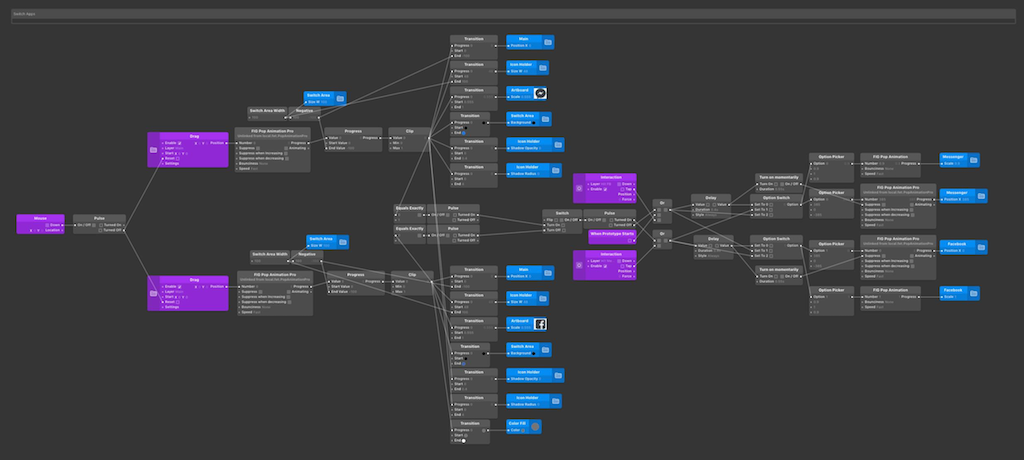
Erasure Meditation
April 7, 2018
I recently had my worldview forcefully re-centered by Steven Pinker’s book Enlightenment Now. It vividly illustrates that the world is categorically far better than it has ever been, while also being ever more obviously in dire need of further improvement.
An idea appearing at the end of it really knocked me over: the “global workspace” model of consciousness, and specifically the blackboard metaphor thereof. This is the idea that the many modules of your brain have a common area for posting up information to be shared with the others. Each module does lots of subconscious work off on its own, but then can scribble their results on the central blackboard, erase bits, and read the other modules’ results in order to work collaboratively. (Sort of like the top levels of the memory hierarchy in a computer, where only the data being actively processed is moved into place for quick access.) Here’s the exciting part: perhaps the blackboard literally equals consciousness. Like, what if consciousness is what it feels like to be the workspace for a bunch of brain modules, where they write information to be shared, and to be the process that evaluates the disparate contents of the blackboard and synthesizes them into coherent ideas? That’s exciting!
The unexpected benefit of discovering this model is that now I have a new meditation technique. When thoughts attempt to get thought in my brain, I imagine them as words and images being written on the blackboard. That’s fine — I patiently watch them be written there, and then calmly erase them. Often, before I can even finish erasing the last thought, the next one is being written, so I then move on to erasing that one. After a while, sometimes I can keep the blackboard blank for a few seconds at a time. Focusing on the image of the board being continually erased is a perfect way to allow thoughts to arise, but to avoid getting carried away by them. I imagine that the better one gets at meditation, the more blank blackboard time they can achieve.
The Discipline
March 22, 2019
After ten years away, I reread Anathem by Neal Stephenson, a book I’d suspected might be my favorite novel. Now I can say that it is. It’s set in a culture of monastic mathematician-scientist-philosophers who retreat from society for one, ten, one hundred, or one thousand years at a time. They disconnect from the banalities and frivolties of the world to focus on long-term contemplation and study. The premise is so nerdy and esoteric that I kind of can’t believe that a book so perfectly aimed at my brain exists, is popular, and is so good.
Upon returning from three slow-paced, minimally-connected, meditative months in Tokyo, I took inspiration from the avout of Anathem and planned out a miniature version of their Discipline to decide how to spend my available time. I am doing my job, participating in my family, and keeping up friendships normally. But the precious time that remains, which it’s so easy to fret about using properly and so easy to waste, is now neatly allocated by the Discipline.
Each day has a focus assigned, from among five possible focuses:
⌘ Connect — Catch up on what’s going on in the world and generally be a normal modern human.
❥ Read — I read at least a bit every day anyway, but on a Read day, I’ll try to spend all of my available time reading. This should be solid, healthy stuff with something to teach.
❖ Study — Deliberately trying to understand or get better at a specific subject. Lately it’s been programming Haskell; later it may be systematic study toward level N1 of the Japanese Language Proficiency Test.
✿ Play — Allowing my mind to get carried away by something imaginative. A video game, comic, concert video, or whatever other input that seems worthwhile if not entirely intellectual.
✽ Create — I’m writing this guide on a Create day! This could also mean building software, playing music, drawing pixel art, working on websites… any variation on making something.
Time is divided into ten-day decades. (We commonly use the word “decade” to mean ten years, nowadays, but prior to the 16th century, it could mean any collection of ten things, including days.) I love my desynchronized rhythms; the 10-day decade and the 7-day week create a healthy polymeter that drifts in and out of sync over time. At the start of each decade, I choose a template for how I’ll spend the next ten days worth of available time.
The standard decade is ⌘ ❥ ❖ ✿ ✽ ❥ ✽ ✿ ❖ ❥. There are other templates for when I want to bias toward a particular pursuit or two for the next decade, but every template includes each pursuit at least once. For instance the Study Focus decade is ⌘ ❖ ❥ ❖ ❖ ✿ ❖ ❖ ✽ ❖. Create & Play Focus is ⌘ ✽ ✿ ❥ ✽ ✿ ✽ ❖ ✿ ✽. And so on.
Note that Connect only happens once every ten days, and it’s always the first day. The first-order aim of this system is to spend nine out of ten days disconnected from the wider world, focusing on deeper, longer-term concerns. At its heart is the thesis that something that’s not of value after ten days is not of value. Now — remember that this Discipline is about available time left over after fulfilling the responsibilities of the day. So I still talk to friends, family, and colleagues every day.
Connection that can happen on any day:
- One-on-one conversations with friends
- Reading posts and emails
- Hanging out, or making plans to hang out
- Doing my dang job
Connection that happens only on the Connect day:
- Reading the news
- Watching videos (YouTube recommendations fill up with genuinely good stuff if you only check them every ten days!)
- Hanging out in close-knit online communities of friends
Connection that shouldn’t happen:
- Spending time on public online spaces like Twitter, where intense stimulus goes past faster than you can properly process it
- Clicking around sites like YouTube or Reddit, seeking out something to spend time and attention on
On an ordinary day, the goal is to do the focus pursuit at least a little. Writing for 20 minutes on a Create day is good. Getting through a chapter of Haskell exercises on a Study day is splendid. It’s also fine to move on to other pursuits if I’m already satisfied with how much of the focus pursuit I’ve done for the day. If I end up with no available time at all, that’s okay too; it means I had lots of normal responsibilities to take care of that day.
Some people I’ve described this system to say that it sounds tiring. When their available free time finally arrives, they feel too exhausted to do anything but turn their brain off and watch dumb videos or TV shows. That brings me to the paramount rule of this system: when in doubt, go to bed. If I’m exhausted, especially mentally or emotionally, nothing I can do will fix that except sleep and then maybe a good morning meditation.
So that’s how the Discipline works. After practicing it for sixty days, I’ve found that so far it’s solving the problems I designed it for and then some. My in-the-moment self doesn’t fret about how to spend time anymore; a wiser, longer-term version of me has already decided it. I don’t worry about whether I’m letting an important pursuit languish too long, because each of them happens at least once every ten days. I genuinely care way less about the frivolous, day-to-day nonsense of news, politics, and online life. When the Connect day comes, stuff that would have consumed hours of my attention every day now seems downright dumb. Oh, and of course, I’m making steady progress on things like learning functional programming, absorbing heaps of books that are utterly worth every moment I spend on them, and writing my own little book.
(In retrospect, this is an upgraded version of an older system I developed, Periodic Table of Priorities)
Two Music Albums For Your Consideration
I’ve been hooked on two very different records lately. Spangle call Lilli line’s fresh and miraculous 11th album Dreams Never End (especially the song “mio”) and Yes’s underrated 1994 masterpiece Talk, which I imagine sounds cheesy and dated to almost anyone today but which I genuinely can’t get enough of. Both are fine specimens of the genuine warmth and positivity to be found in YouTube comments on music these days.
How to Pause
January 31, 2021
Hallon, I’m apparently joining a couple of friends like Sarah and Ash by, while not having intentionally and officially stopped sending letters, starting to send them again.
I tend to believe that for maintaining resilience, your inherent character is less important than the systems you’ve put in place as a vehicle to weather the bizarre world we’ve grown around us. When challenges come, I hope to have some system for handling them, or to develop one anew. And, well, the past year has put all of my systems to the test. The vehicle is windswept and battered; the passenger is shaken but intact. The theme that seemed to emerge for me was “expending a lot of effort in order to feel mostly okay”. Without the systems in place, it would likely have been “despite expending a lot of effort, still not feeling okay at all”.
The past six weeks in particular have been the real trial. I’m on leave from work, running the household of three by myself. Survival has been my only aim, and I’m pretty proud that my systems have allowed me to achieve it. (I think loneliness has been the worst of it. Do say hello!)
One of the most important additions to my all-encompassing meta-system is a new understanding of what to do when life, or the entire world, or both, get too absurdly askew to carry on as normal. My automatic response was to pause all systems and focus entirely on the sudden exec-level design dash at work, the household distress, or the current event of historic gravity. Surely I can’t be expected to run my systems and keep up with all that.
As it turns out, though, there is a sort of hierarchy to the systems that determines which ones are all right to switch off, and when.
- Cadence is an overarching meta-system based on reviews for making sure you’re working toward longer-term meaning. Dropping down to survival mode for a week or a couple of months means pretty much ignoring all of this structure but maintaining the mindset that following it has generated, and looking forward to returning to questions of meaning and self once things are stable again. Pause.
- (One exception to the above is that I’ve found a number of opportunities for microcadences, small but deeply meaningful and affirming experiences, especially during the pandemic when a lot of such stuff has moved online. A virtual concert by a band that means the world to me, two personal screenprinting sessions with my favorite visual artist, et cetera. It feels like a true blessing to be able to continue to pursue such moments among such difficulty. Microcadences are yet another system concept I hope to document soon!)
- Durable Notes is a system for accumulating a library of intertwined knowledge over time, rather than letting it wash past. But when I’m not deeply reading or studying, there’s nothing to accumulate anyway. Pause.
- Commonplace is a system for journaling and generally thinking things out in text. In survival mode its main function is therapeutic, for venting and sorting out thoughts. Inspirational and documentary functions are paused.
- Texture is a system for nurturing loose emotions and reinforcing the sort of person you want to be in the present. Wow, that sounds ridiculous when summarized and I hope to write it up for you soon — but for me it basically ends up involving lots of calm reading, video, and music from subcultures I feel affinity to. (Usually in Japanese, because I’m coping by pretending I’m in Japan whenever possible.) This turns out to be even more important while in survival mode, so I have replaced much of the Discipline with Texture instead.
- The Discipline is a system for deciding how to fruitfully spend available time. But when deep in survival mode, with (at most) zero psychic resources left at the end of the day, I’ve found that I can’t do anything beyond picking one or two default Texturey activities that are at least not bad for me and using those to psychically recharge; the more mentally expensive focuses like Create and Study, and even Play, are set aside.
- Be Well v2 is a system of “wellness for the reluctantly corporeal”. It’s less about ambition to get healthier or more fit, and more about recognizing that if I don’t maintain a baseline level of health, I’m certain to be useless and miserable. I must never pause this system. Even in survival mode, there’s a floor on the amount of sleep, activity, and meditation I need, and falling beneath it will interfere with the aim to survive.
The lesson here was, apparently, that it’s okay to pause your cerebral, ambitious systems for success when things get dire. But it’s not okay to pause your systems of nurturance and well-being. You’ll need those more than ever.
Incantation 1 – What if you just didn’t?
November 26, 2021
There are a few commonsense exhortations that I have found that function like magic incantations, cutting through unhelpful thought patterns and wresting me back into a reasonable state of mind. I’d like to write about three of them in turn:
- What if you just didn’t?
- So what are you going to do about it?
- Okay, compared to what?
The first comes from the article “How To Talk To Girls On Twitter Without Coming Off Like A Creepy Rando”, now a venerable six and a half years old. For whatever reason, this line immediately embedded itself in my mind like an ancient proverb. What if you just didn’t? Would you die?
I don’t think I was quite the target audience for that article, as someone not really in the habit of approaching strangers of any gender in any context, even on Twitter. But the words are electric with what seems like a generalizable potency. How seriously do we consider the option of just… not doing something? Especially if it’s so easy to do, and has no obvious, immediate downside?
Not only “What if you didn’t @ strangers on Twitter”, but what if you didn’t say anything on Twitter at all? What if you didn’t look at Twitter either? What if you didn’t jump in to add your opinion to a conversation where it’s not strictly needed? What if you didn’t even feel the need to have an opinion, on things you’re not an expert about? What if you didn’t bring up the anecdote that makes you look cool, even when it’s tangentially relevant to the conversation? What if you didn’t honk your car horn at the inconsiderate BMW? What if you didn’t even try to bring justice to the neighbor who threw dog waste in someone else’s recycling bin? What if you were generally quieter, waited a little longer to consider whether your voice is truly needed, spent more of your time and attention cultivating your thoughts rather than announcing them?
Perhaps it’s funny that I’m writing this in an email that I had the presumption to put into your inbox. I think I’ve gone from:
- Thinking that I need a mechanism to say stuff out loud to the world several times a day (Twitter)…
- To emailing only when I had something worth writing several paragraphs about (Microcosmographia)…
- To focusing on sharing only things that are worth putting in a book (Cadence), and reserving these emails for early drafts of book sections.
Everyday thoughts still need somewhere to go! But consider this newfangled outlet for them: private conversations with trusted friends! I certainly got into the seemingly common brane-mode of assuming that of course all conversations should be had in the open, with all strangers invited. Or at least that the purpose of private conversations was to generate fodder for tweets. The weirdly simple app Marco Polo has unlocked several friendships that were stuck in the “occasional texts and rare coffees” mode, pushing them into deeper and more meaningful territory than they ever reached even when I saw those people face-to-face regularly. Now nearly everything I would have been tempted to tweet about in 2015 becomes a personal video message to a specific friend who I know will appreciate it.
Next time: “So what are you going to do about it?”!
P.S. After about 20 years of metal bat dot com, I have a new personal site: 1651.org
Elementary particles of meaning
December 24, 2021
One of my favorite moments in deep discussion with a dear friend is when the conversation seems to hit bedrock.
Jon Bell and I talk quite a lot, and one thing we both love about the friendship is trying to understand the other person’s taste, especially when there’s a strong taste contrast between the two of us. While he explains DJ sets and hip-hop and standup comedy; I explain earnest, intimate Japanese indie acts and Dwarf Fortress.
Right now he’s reading Our Mathematical Universe, the book most influential on my philosophy, and sharing impressions as he goes. What’s exciting is that we seem to have found something fundamentally different about our minds. To me, coming to deeply understand something true about the universe itself is one of the most meaningful experiences imaginable. For Jon, if there isn’t any tangible bearing on any human’s living experience, what’s the point?
We arrived at the idea that perhaps each person has a unique set of elementary particles of meaning: types of experience that are inherently meaningful in some primal way, and that can’t be reduced to any more fundamental parts. Experiences that, when you have one, you can’t explain “what you get out of it” or how it supports some other goal. It is the goal.
Some of mine seem to be:
- Understanding something fundamentally true about the universe
- A sense of utter welcome and belonging, outside of time and space, as in certain intimate concerts
Some of Jon’s, by his account:
- Play — especially people working together as a team
- Domains that defy “right” answers — exploration rather than conclusions
Now, just like in physics, sometimes we discover that even at what we thought was the most fundamental level, there’s something inside. One piece of a recent series of maturing events I’ve had was realizing that video games are not nearly as essential to my identity as I spent several decades thinking they were.
Take Xenoblade 2, a game I do still have quite fond memories of. In it I unlocked Shiki, a support character whose whole theme was books and ancient learning. Like, she spouts esoteric lore while punching enemies with tome knuckles. Of course I loved this character and followed all the wincingly dull quests needed to complete her storyline. But why? Because I love games, the characters they can introduce us to, and the lives they can allow us to experience? Because I love the ideas of books and study? But if so… couldn’t I have spent that time reading books? And studying? I could actually get ancient or esoteric knowledge for myself… like Haskell! Or linear algebra! From actual books!
Even books are not fundamental, though. As much warm sentimentality as I feel for them, they’re just a symbol of curiosity and learning. Depending on the topic, a video or a hypertext course may be a better way to learn, and may be more likely to lead to that elementary experience of understanding something true about the universe.
Thank you, and be well
William ended his articles this way, which I always found gentle and kind. That's the end of Plebe #11. Thank you, and be well.